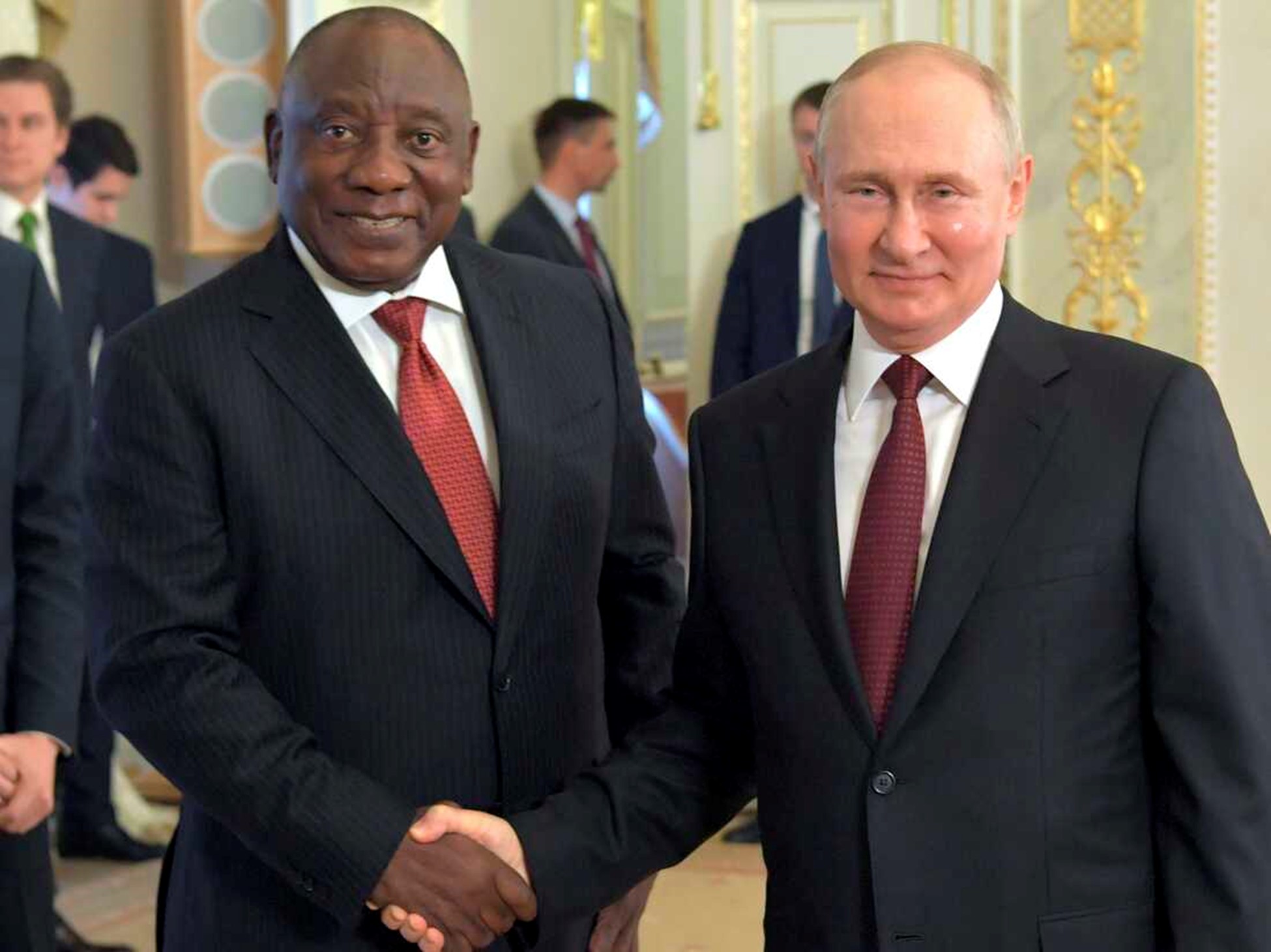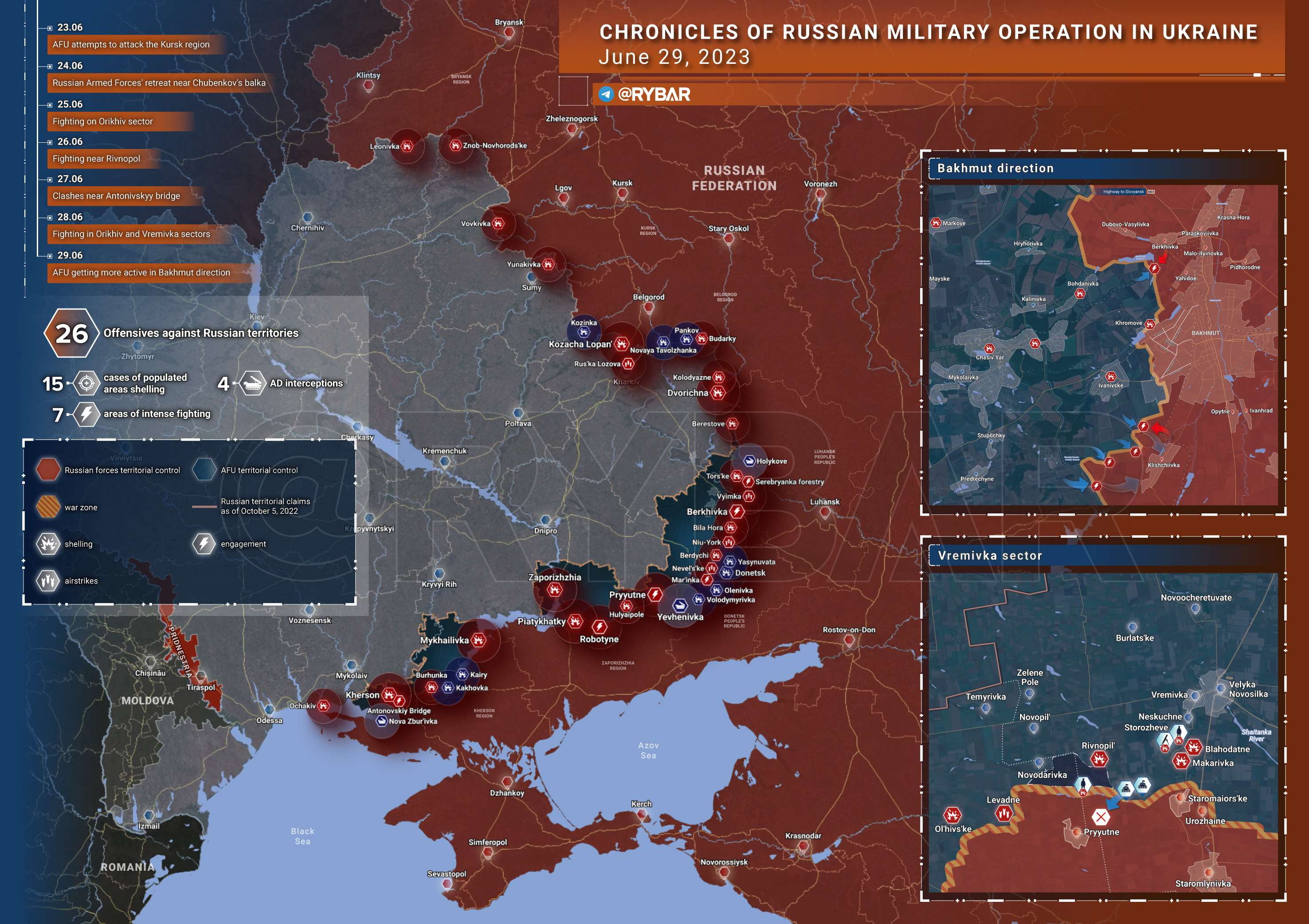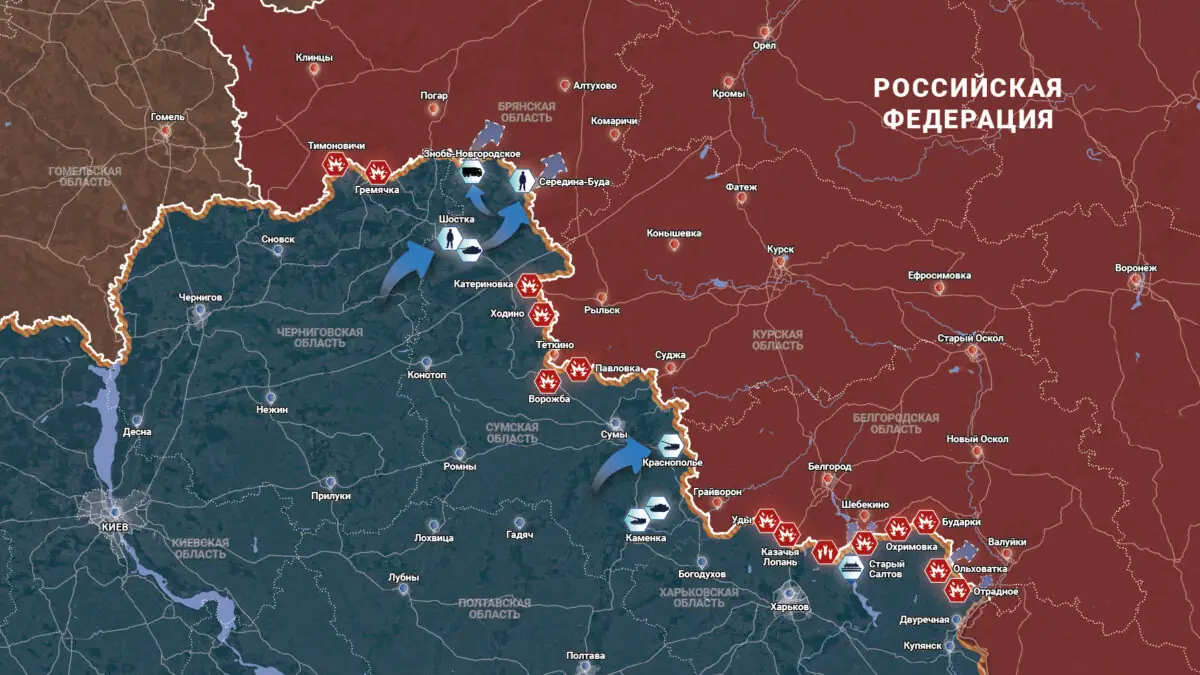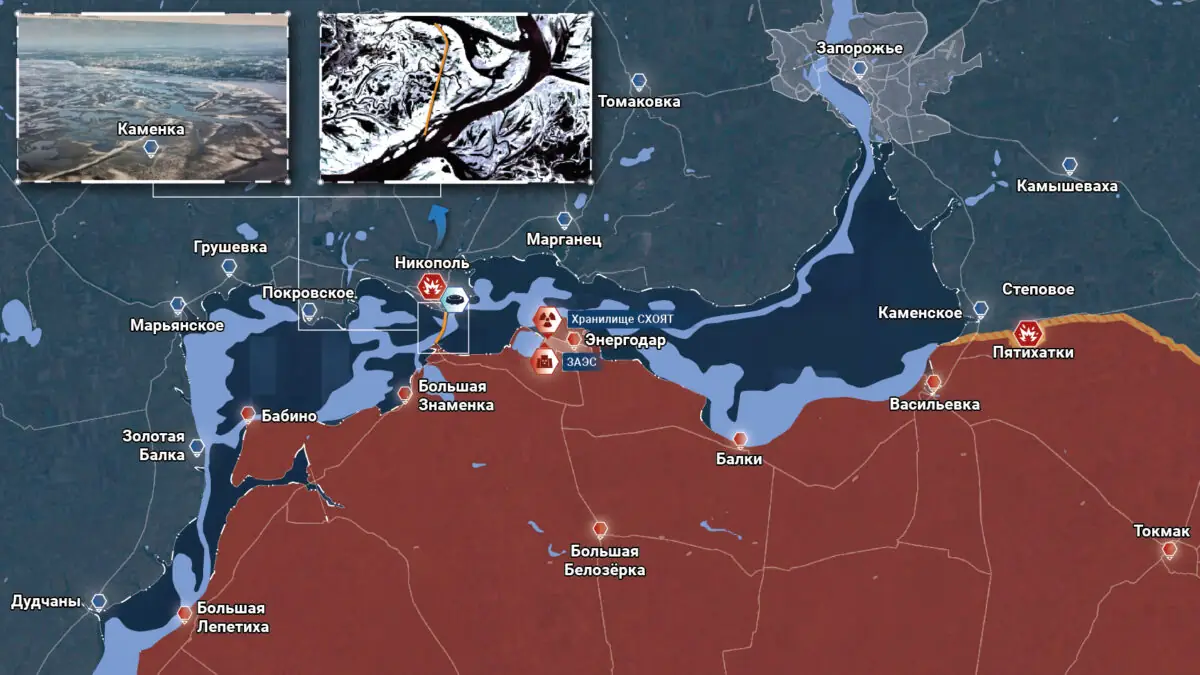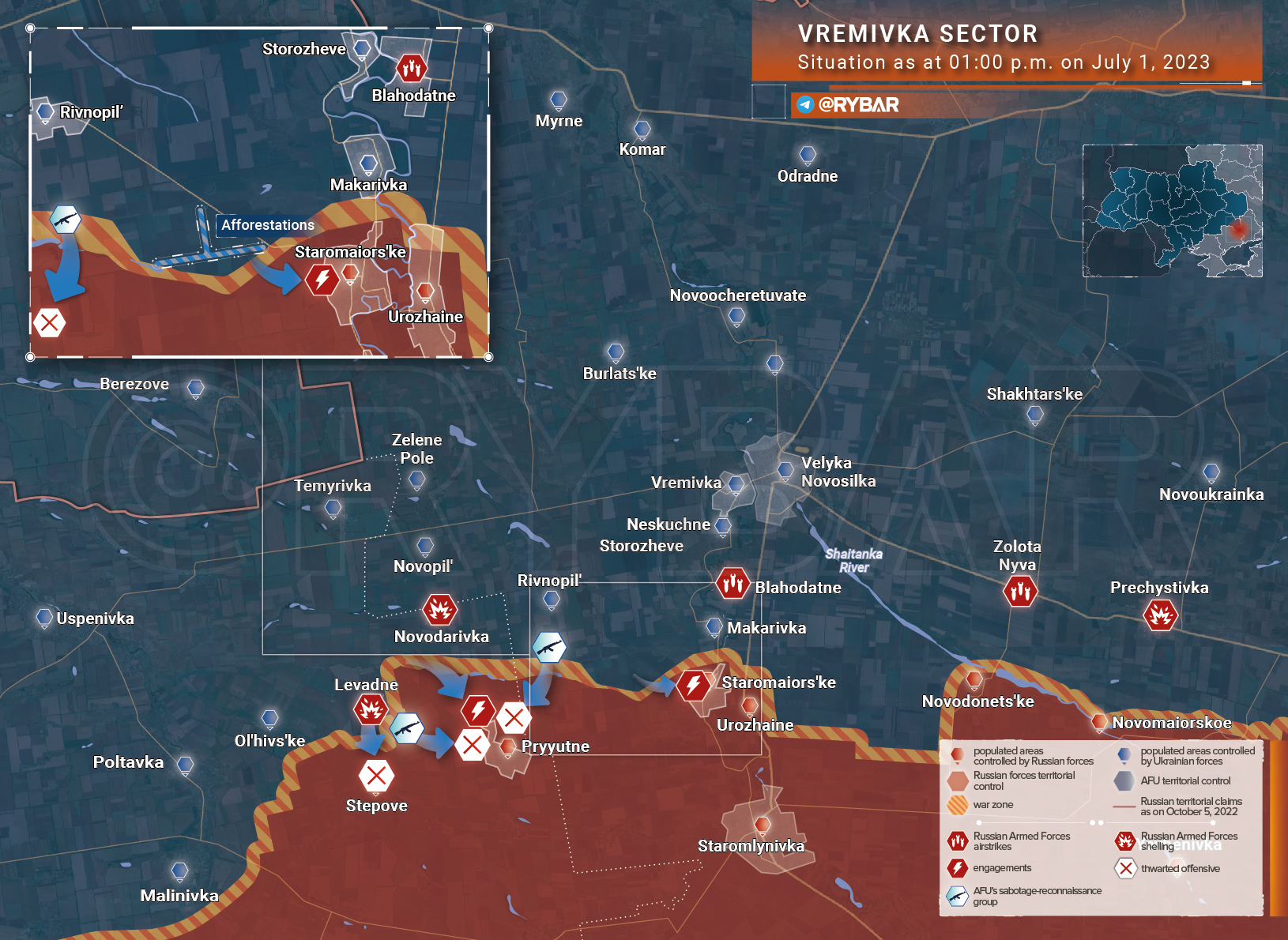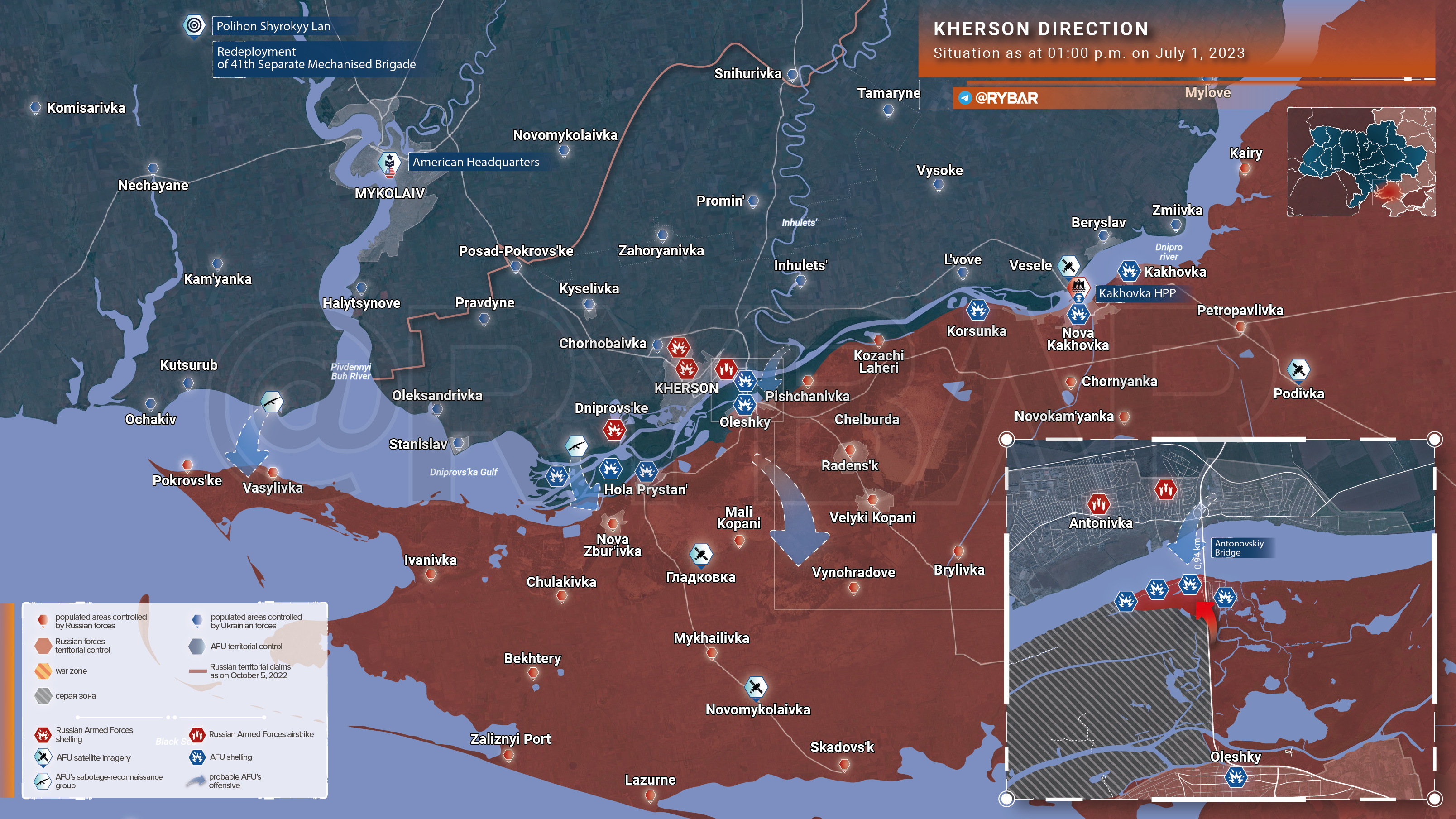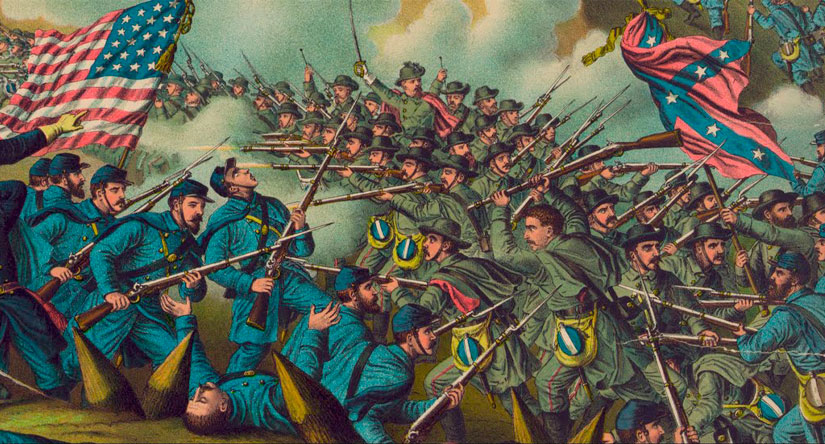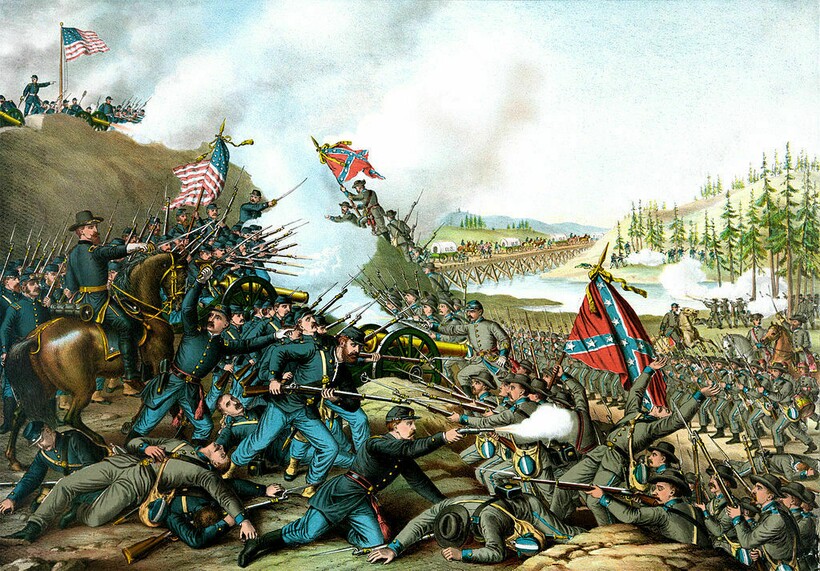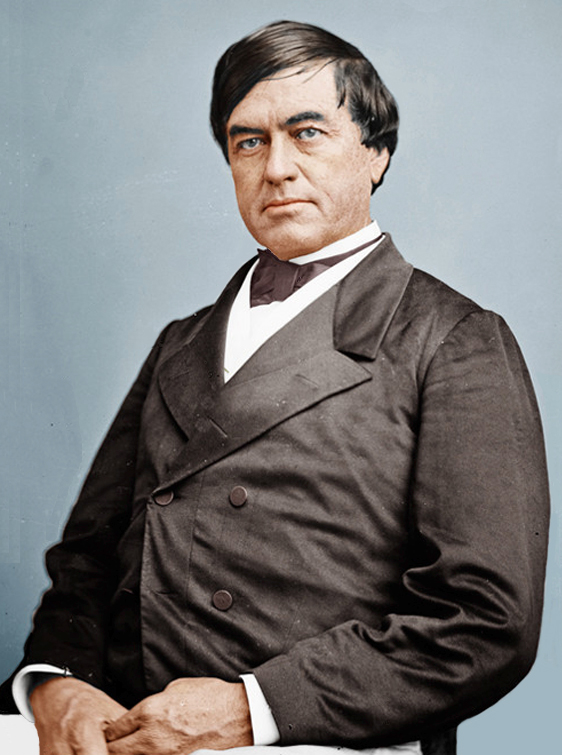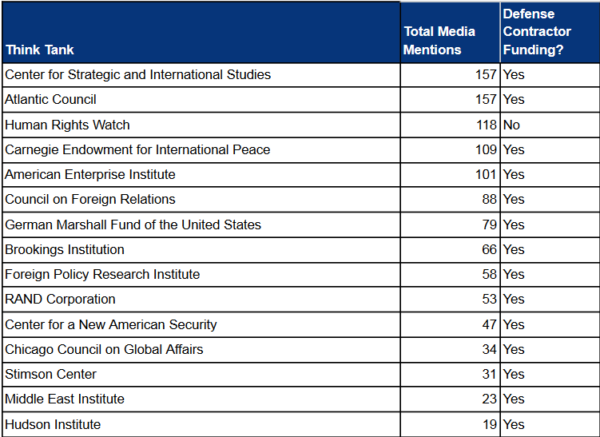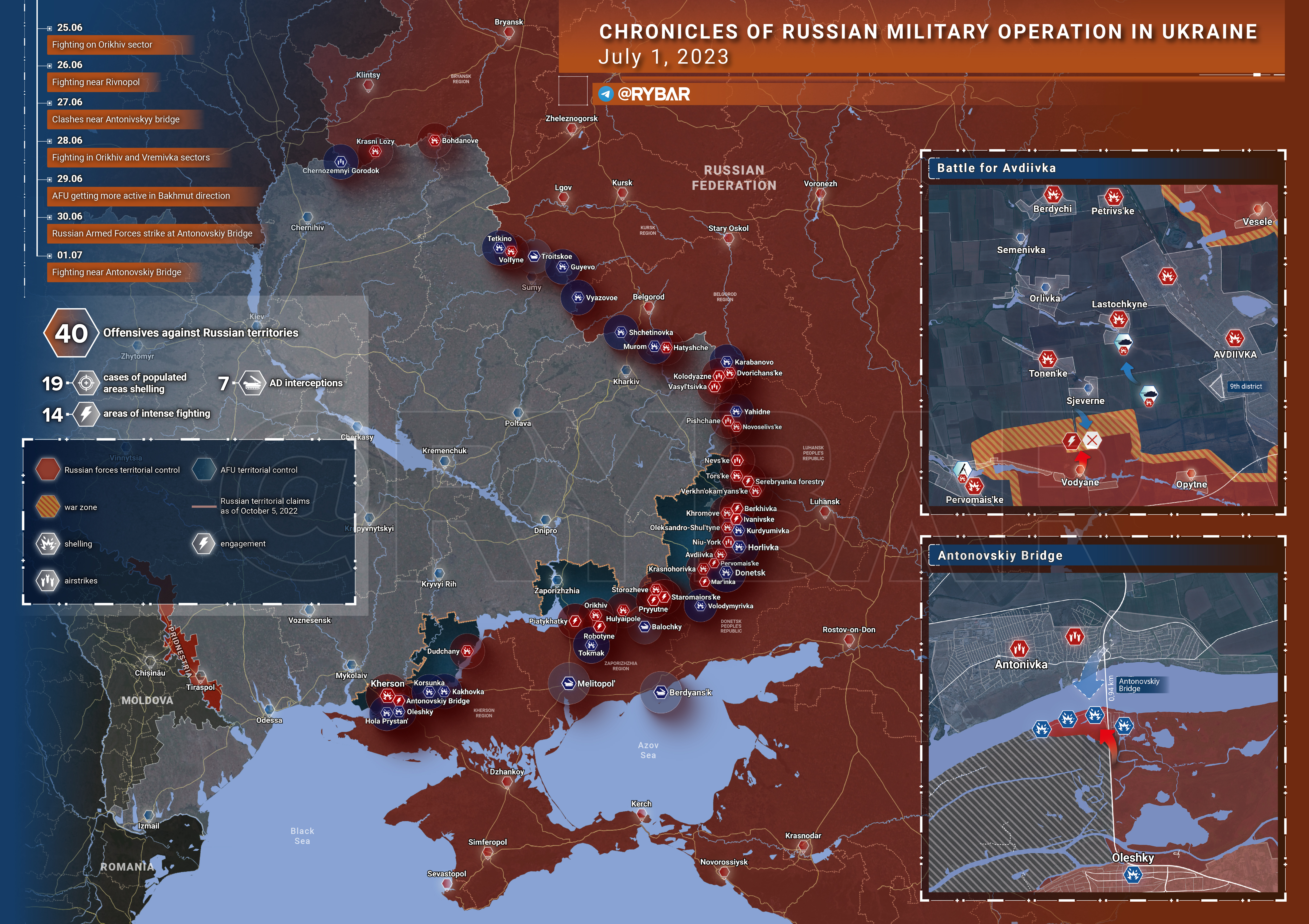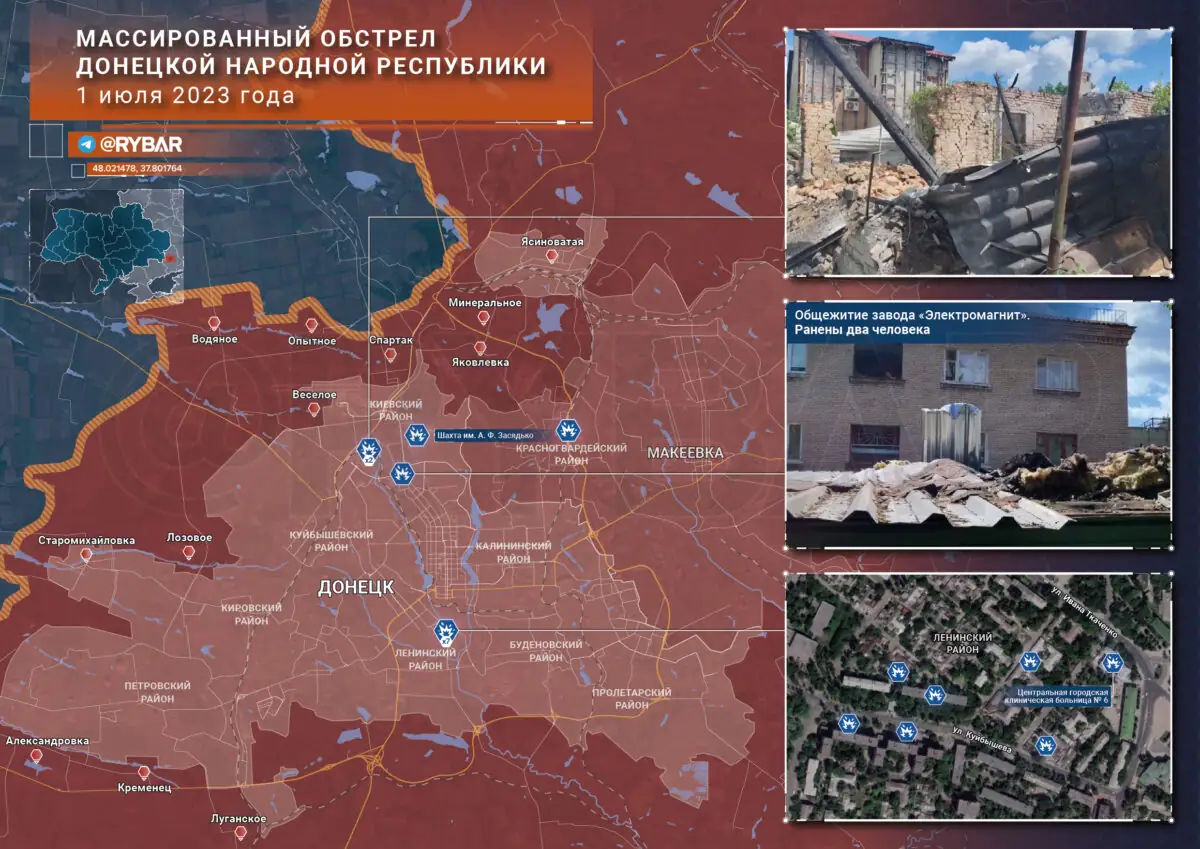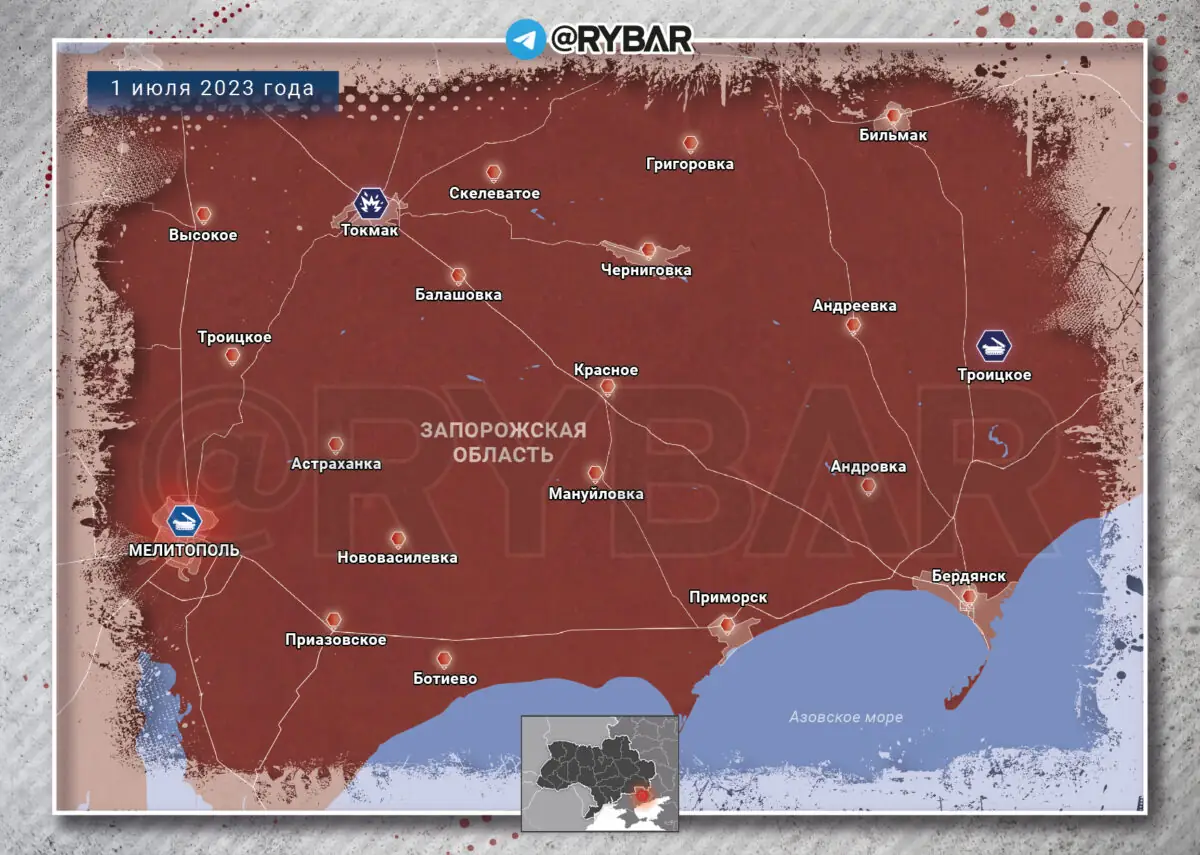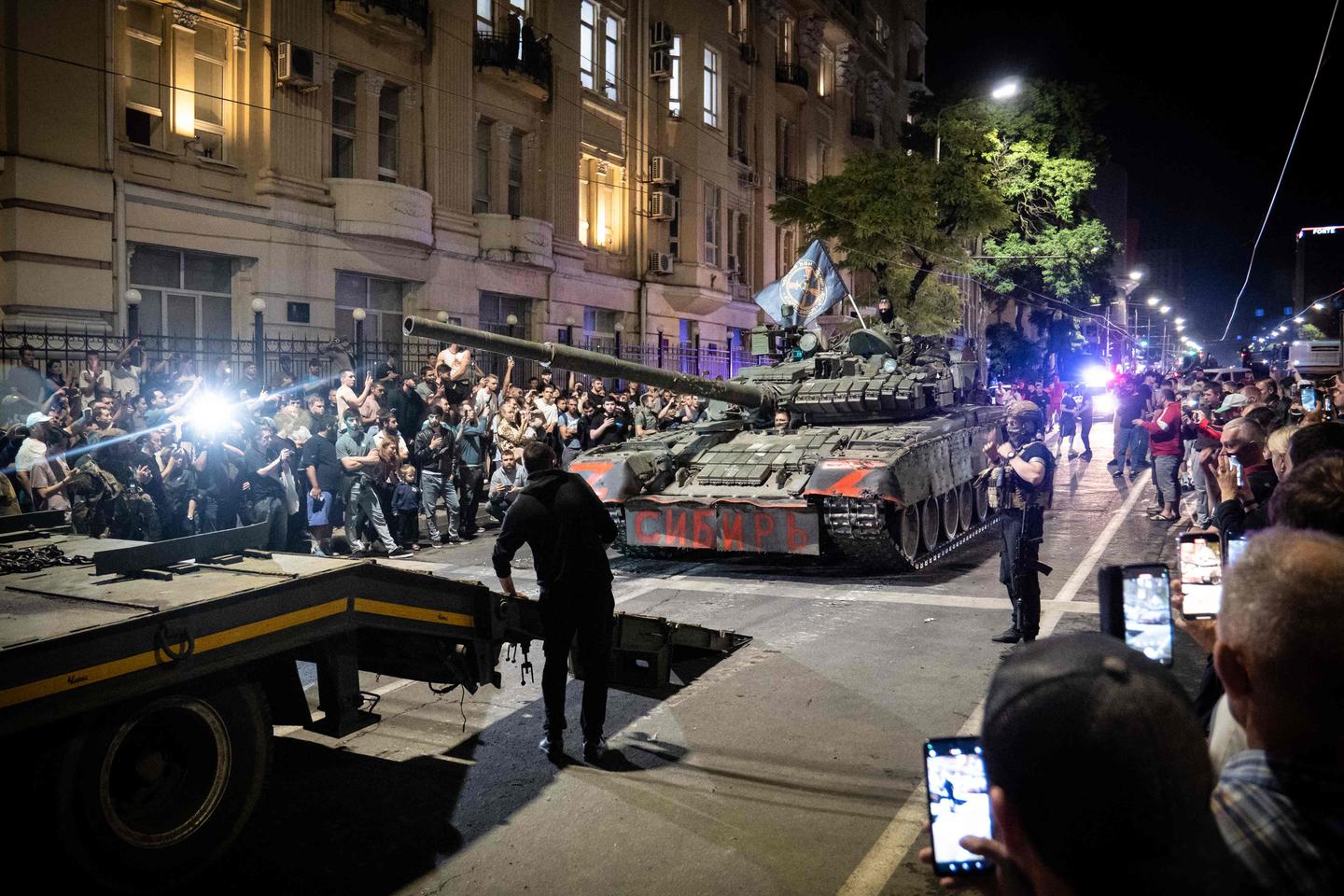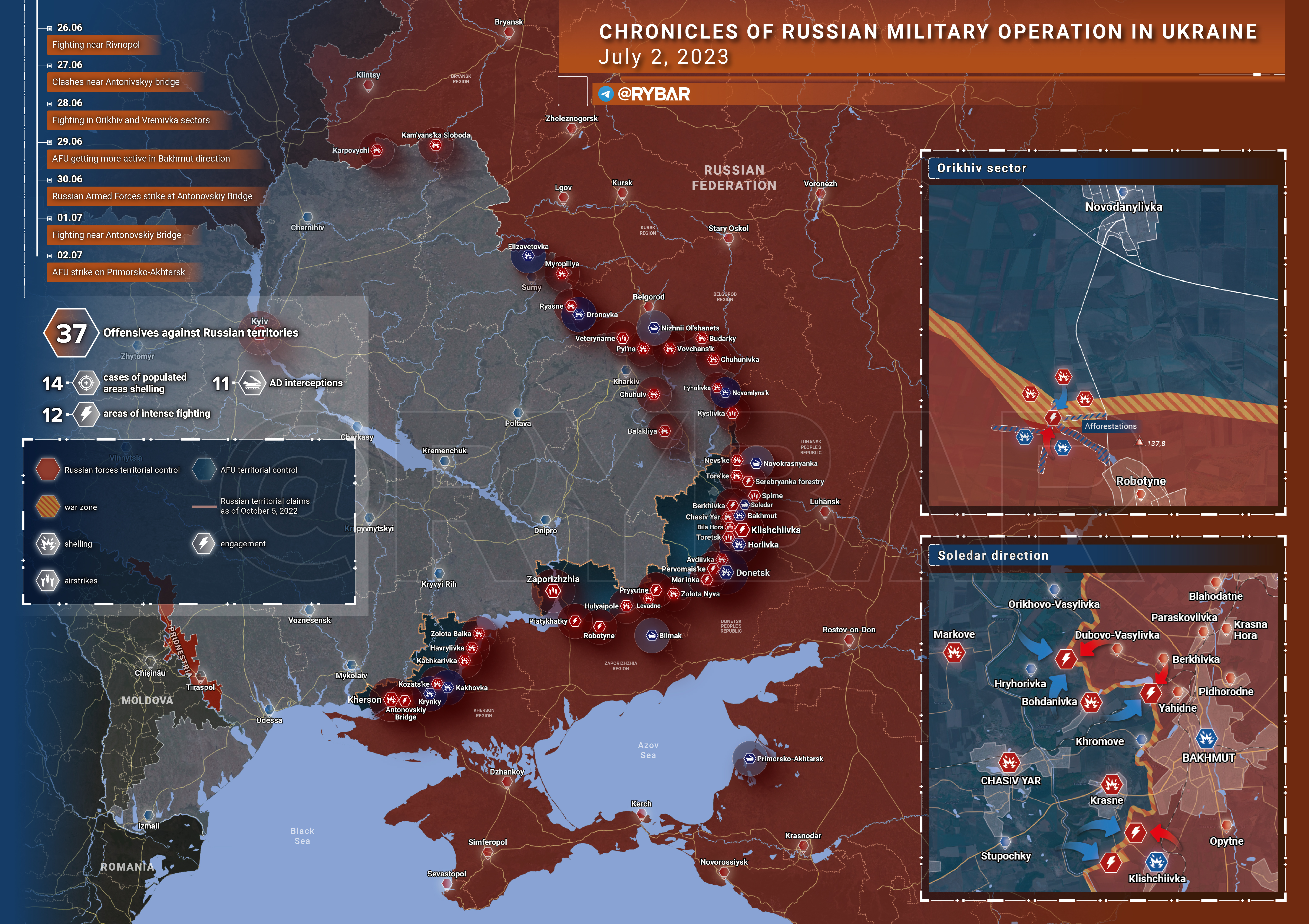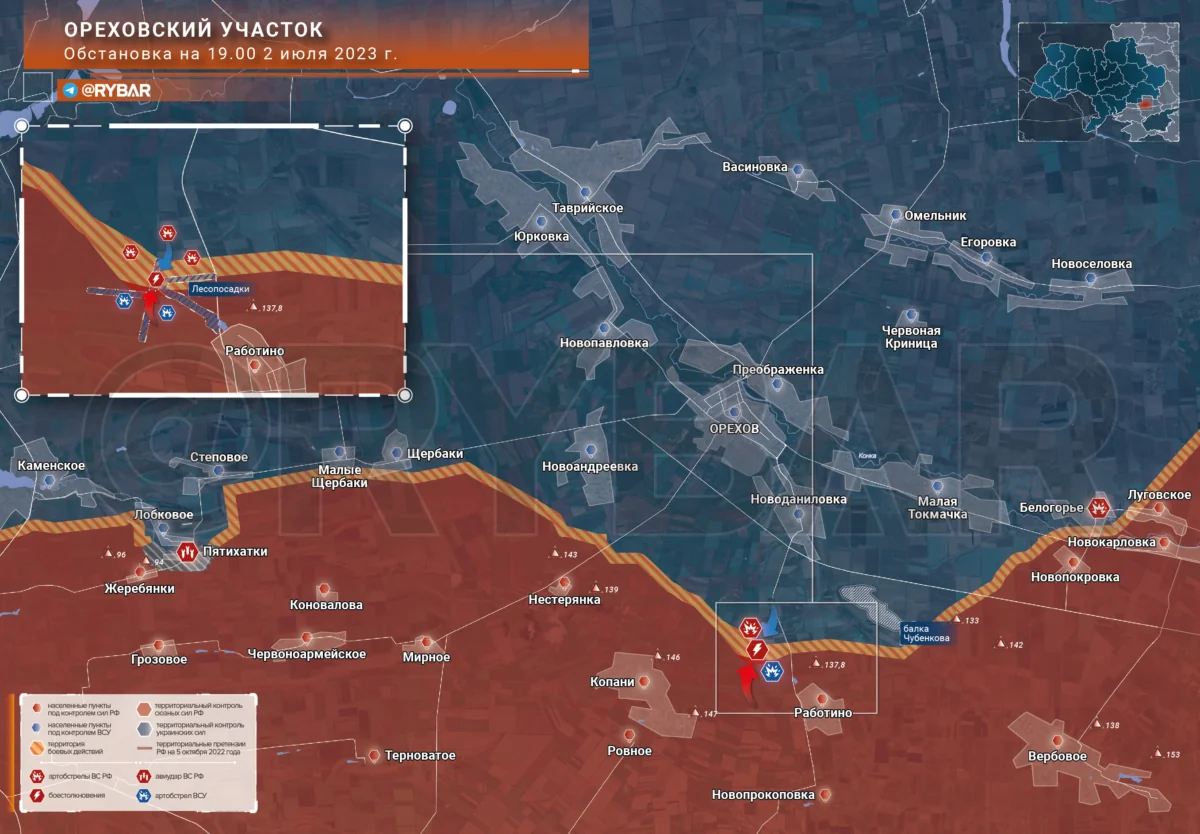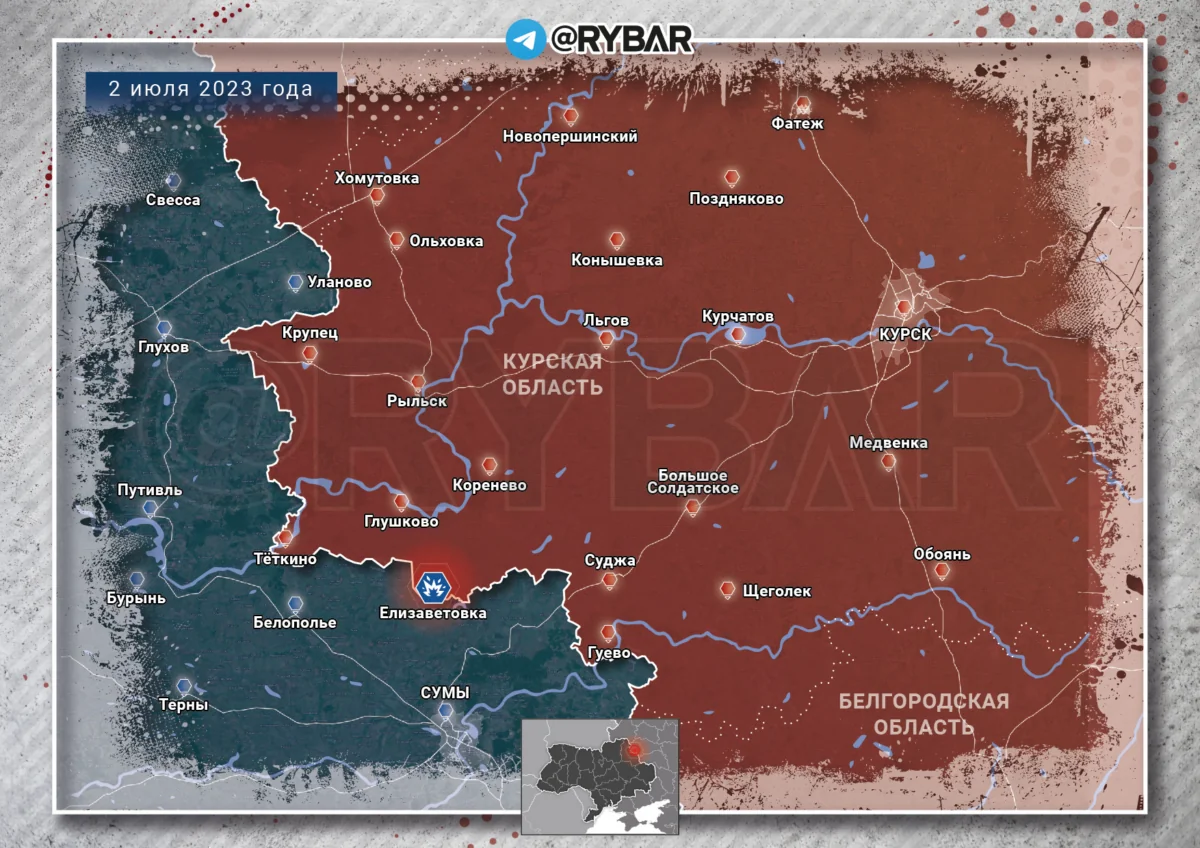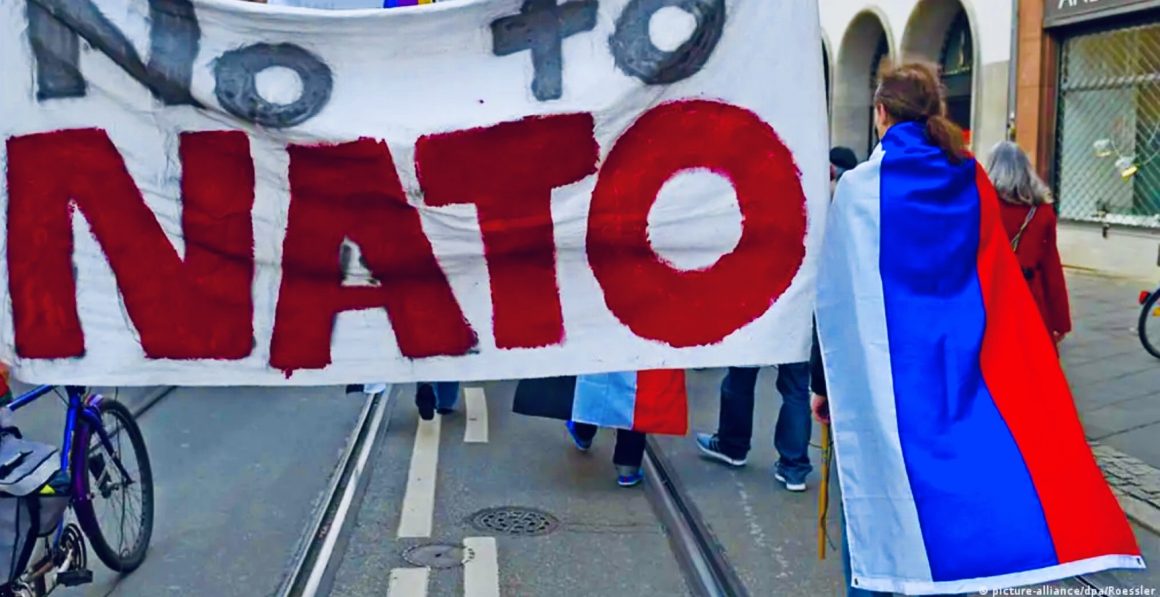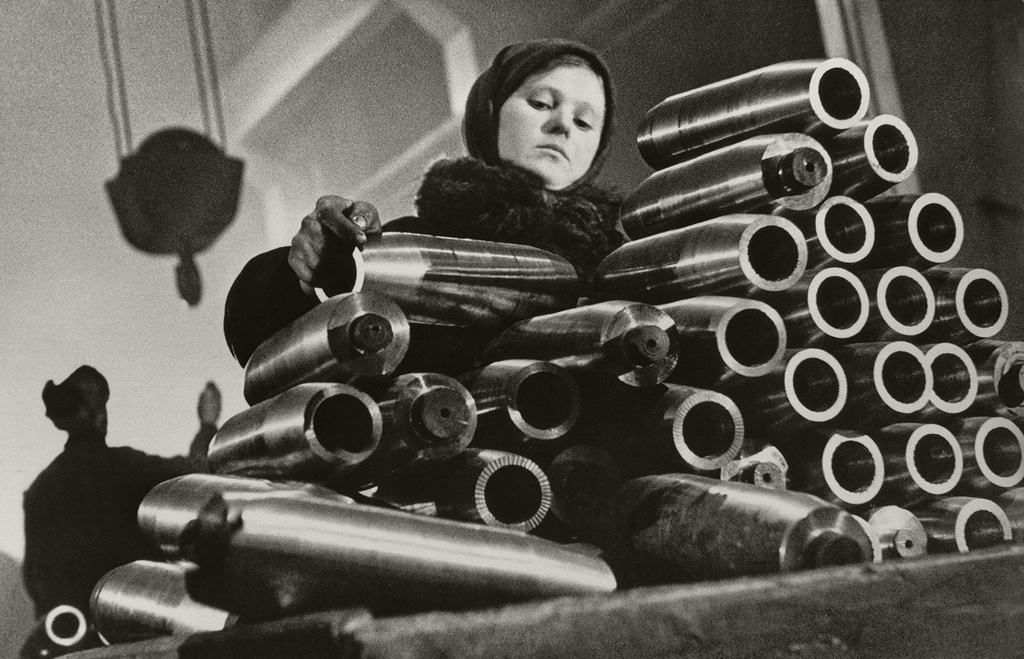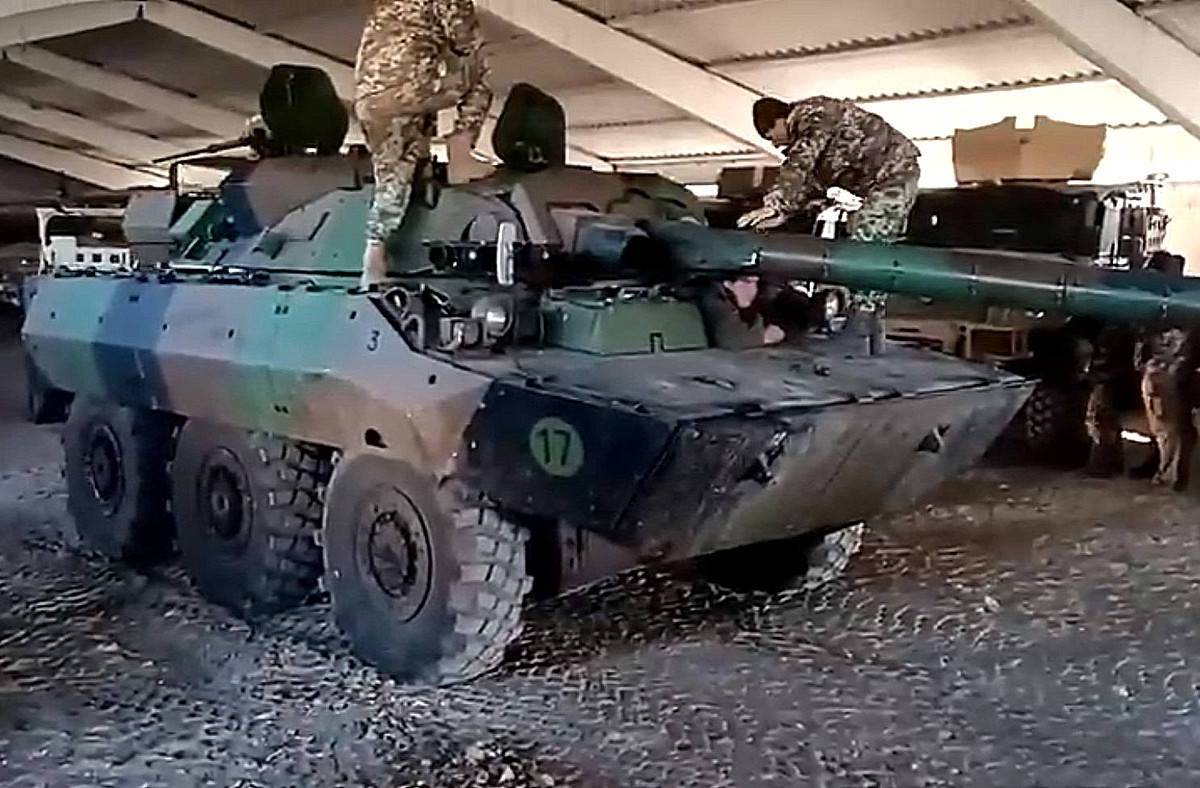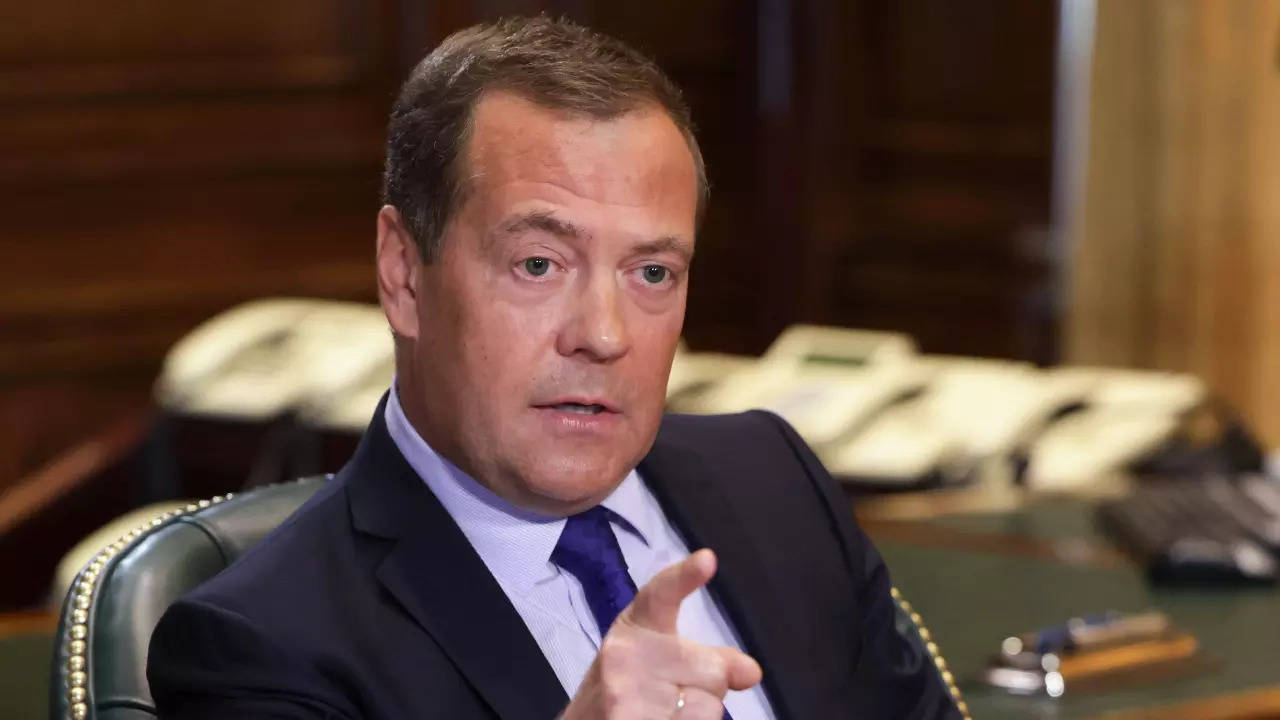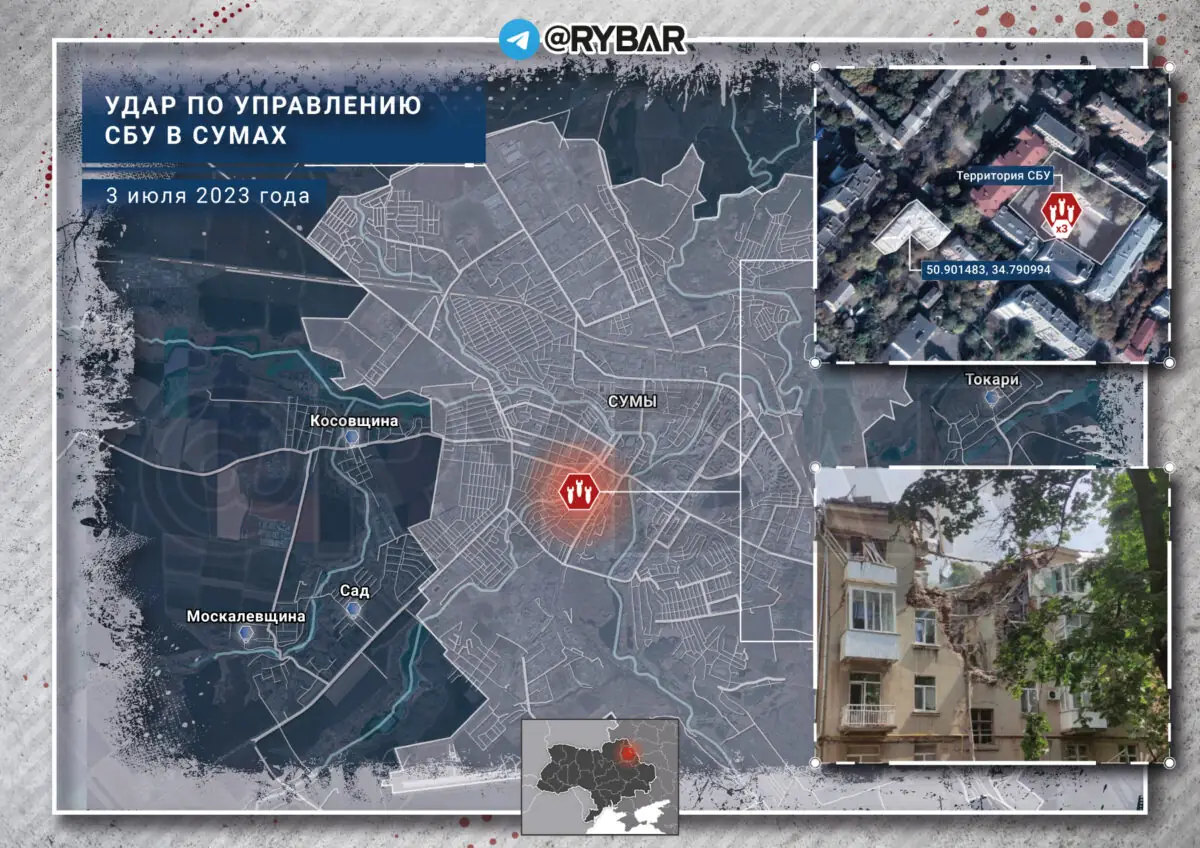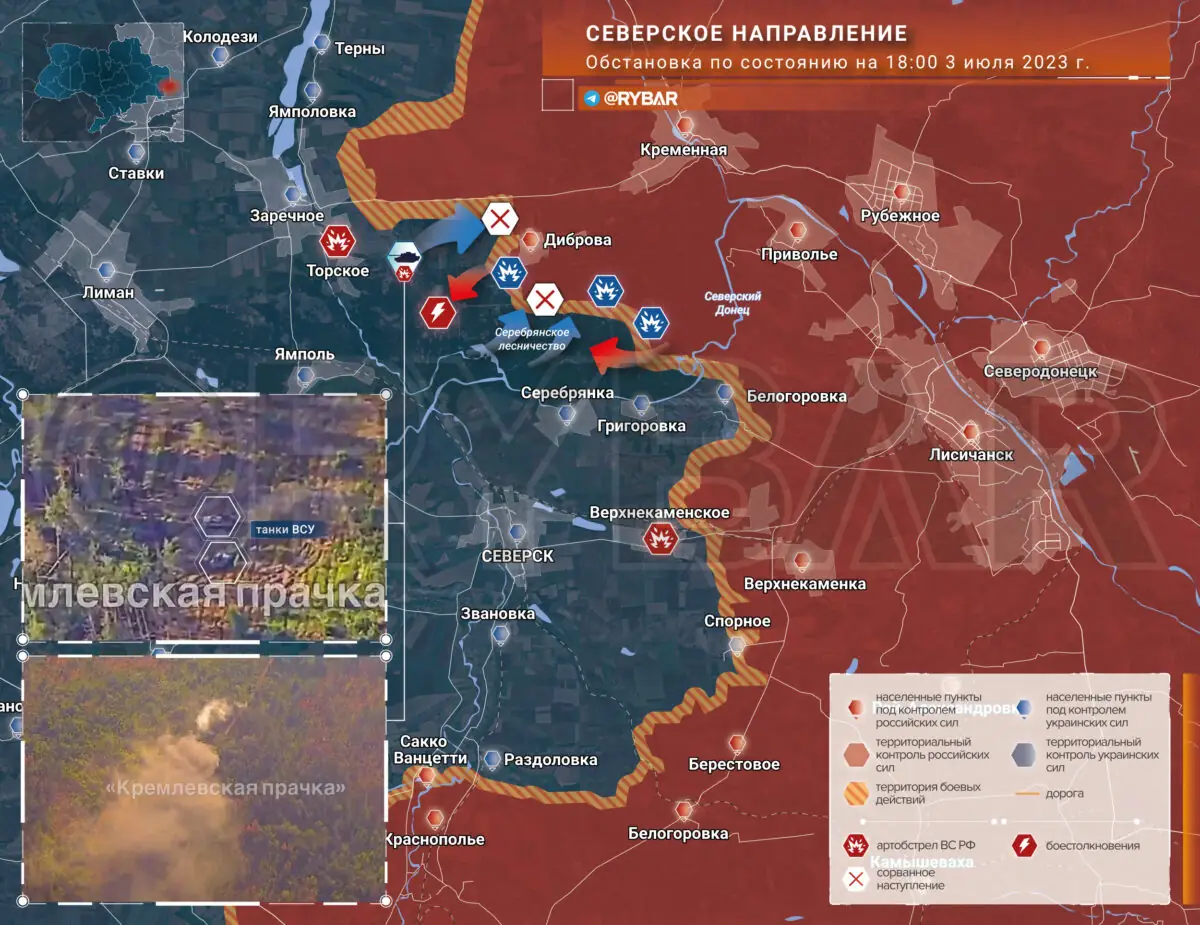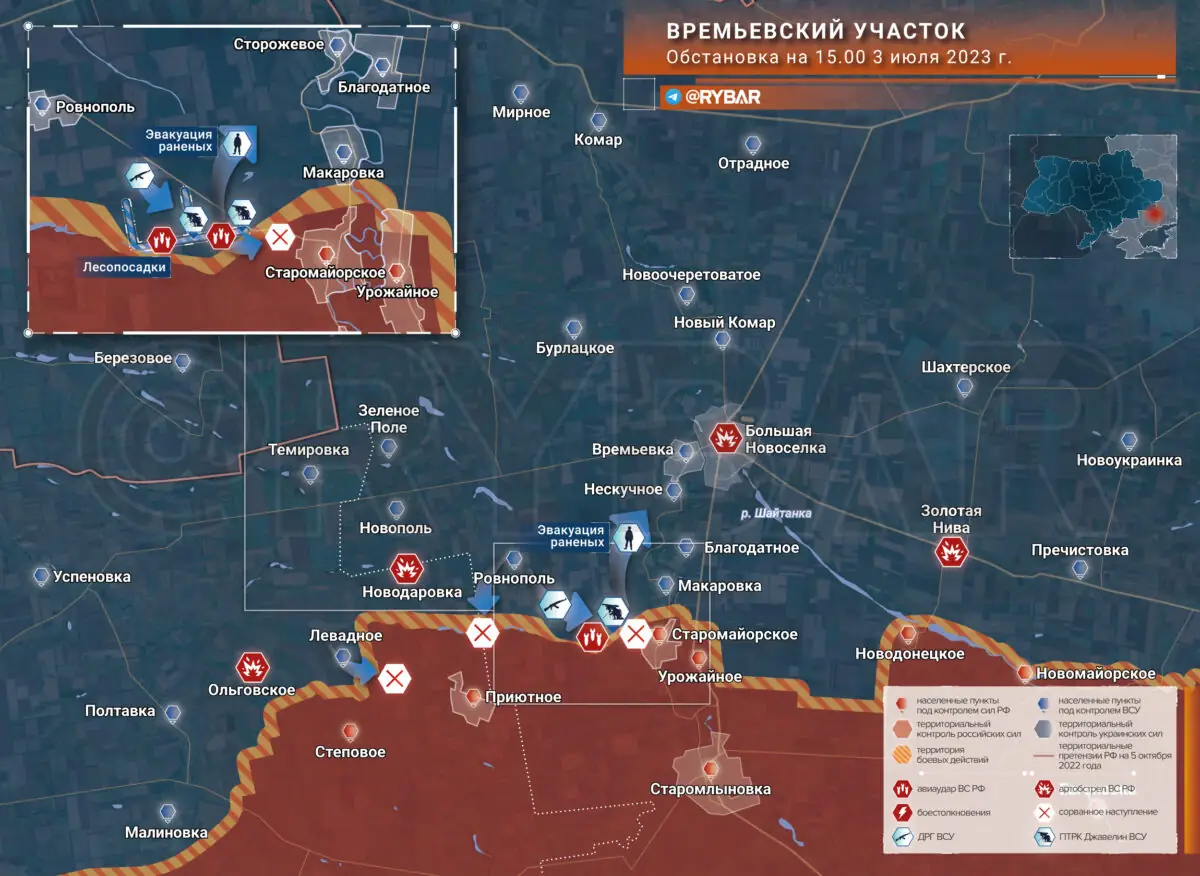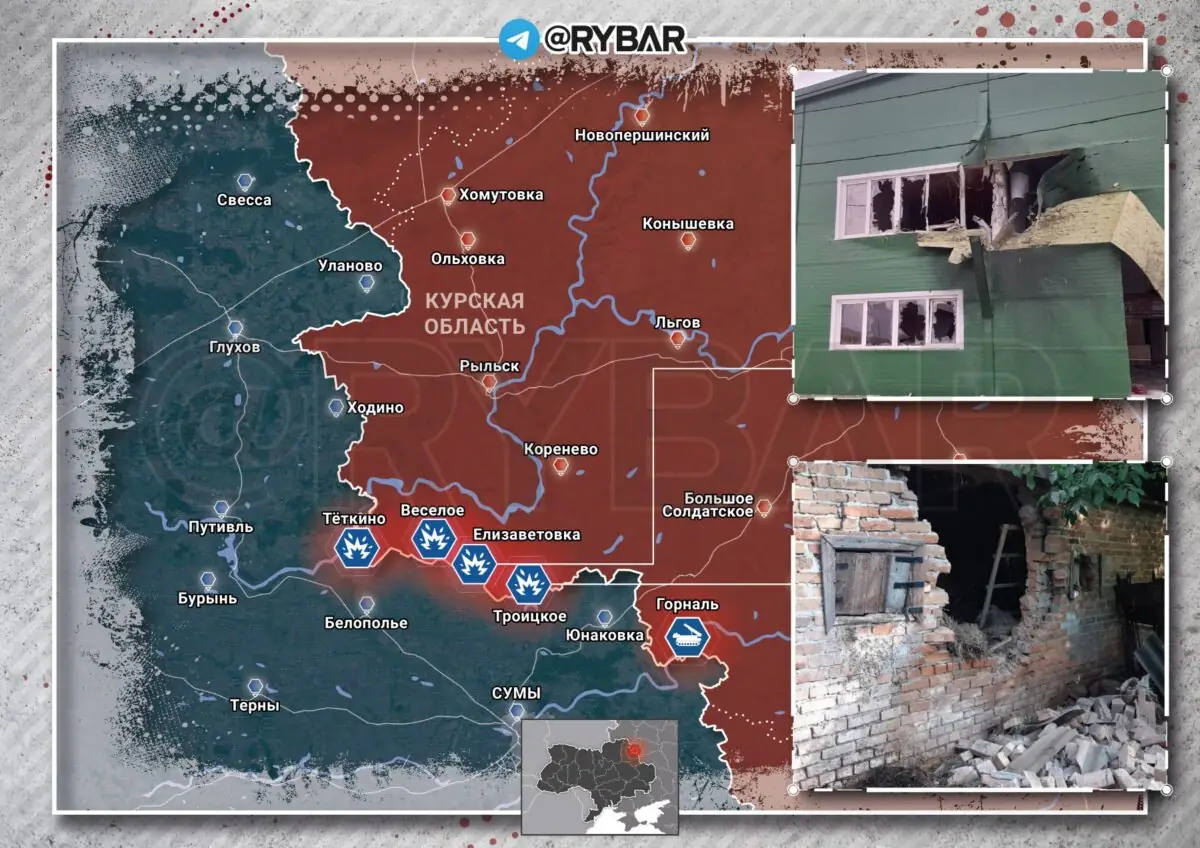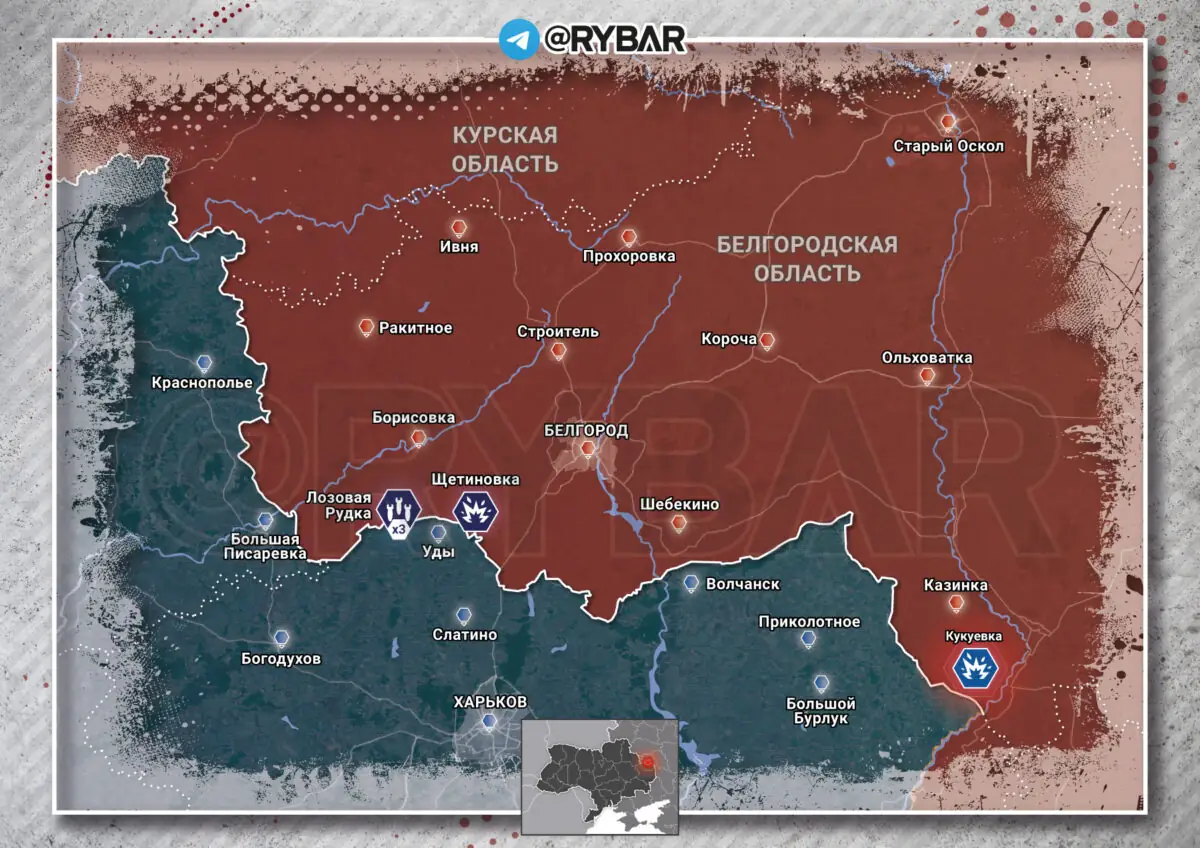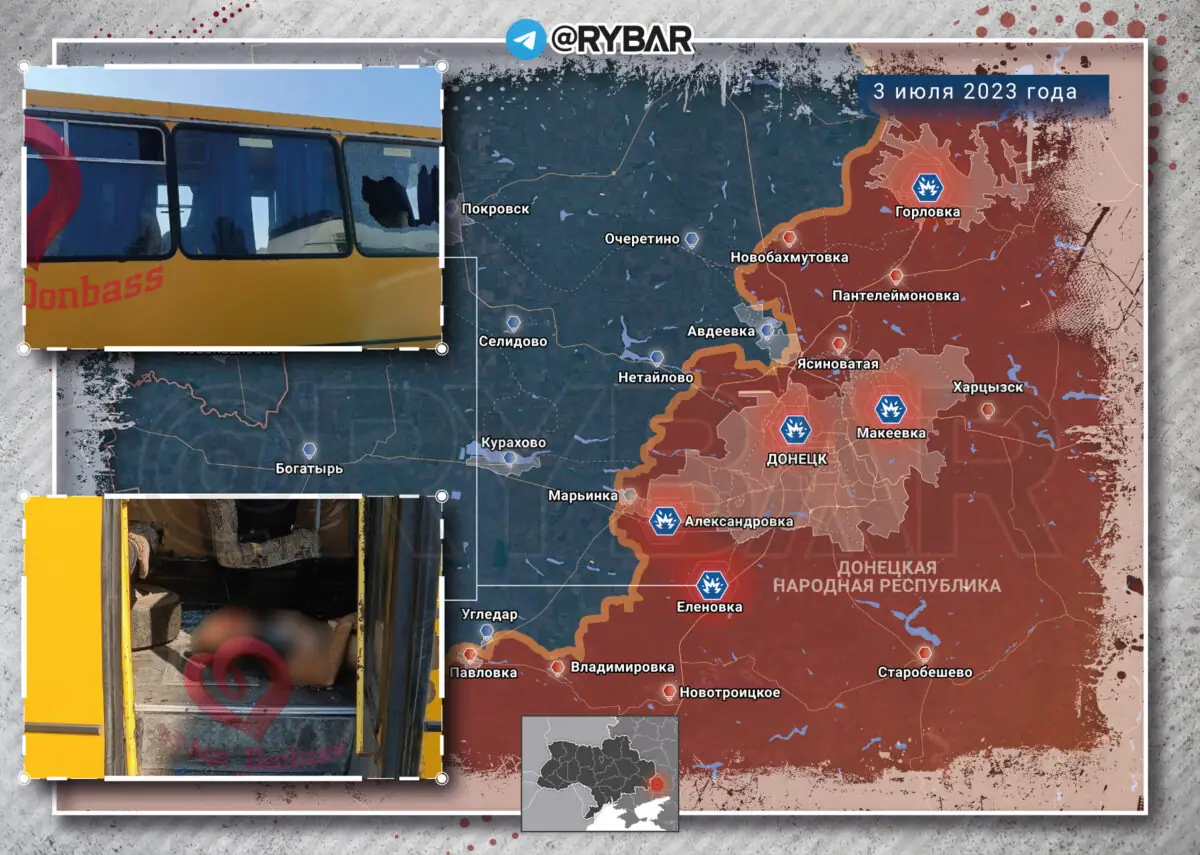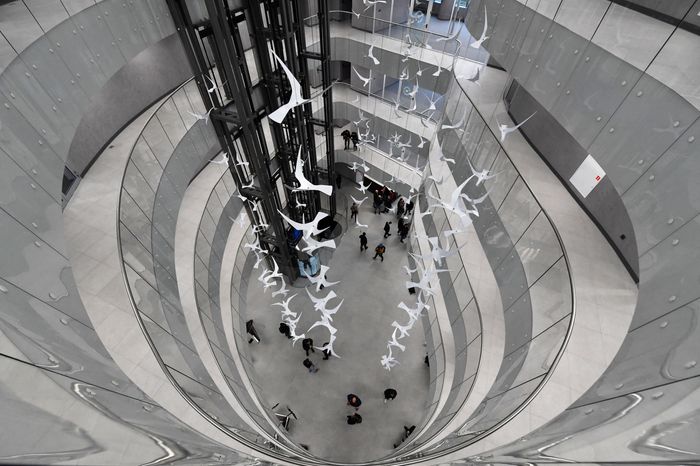POSTED BY @NSANZO ⋅ 06/29/2023

Without the need to intervene or foment a conflict that was always a representation of internal struggles, the United States seeks to maximize the benefits of the armed mutiny led last Saturday by Evgeny Prigozhin. The announcement of the preparation of the delivery of the heavy equipment in the hands of Wagner to the Ministry of Defense of the Russian Federation implies, in practice, the disarmament of the company as a group, at least on Ukrainian or Russian soil. The status and availability of military equipment of the company's soldiers of fortune in Belarus and, above all, in its foreign missions, remains up in the air. This aspect of Wagner's work abroad may be one of the issues that the Russian authorities will continue to negotiate with Evgeny Prigozhin,
It is not yet possible to know what percentage of the company's employees will sign contracts with the Ministry of Defense or how many will move to Belarus to immediately become a tool of Western discourse. Despite the fact that the contingent has not yet arrived in the country, Poland and the Baltic countries have already begun a campaign to demand the strengthening of NATO's eastern flank in the face of the threat of instability that, in their opinion, Wagner poses. Without even needing to assess the combat capacity of Prigozhin's soldiers, their availability of resources or future plans, it can be said that the idea of the fearsome Russian mercenary company commanded by an exalted nationalist capable of putting the dictator on the ropesVladimir Putin is a powerful idea in the hands of the Western propaganda machine, ready to use any argument against his eastern enemy.
Time is showing that, as expected, the consequences for Wagner's operations abroad will remain beyond his participation in the war. When asked what the status of the company will be in the Central African Republic, where Wagner provides security services with a contingent of less than two thousand soldiers, the Russian authorities have replied that "it is up to them." Despite the statement made on Tuesday by Vladimir Putin, who openly recalled that public contracts are Wagner's funding base, Russia seems to return to the idea of ignoring the actions of the company and its mercenaries in cases in which the services are supplied abroad. Until February 2022, Wagner's participation in foreign missions, His contacts with African dictators or paramilitary leaders or his participation in counterinsurgency operations in countries such as the Central African Republic, but also Mali, where Wagner came to share the fight with United Nations blue helmets, accounted for the bulk of Western criticism of the mercenaries of Prigozhin and, by extension, the Russian state. For a time, the war in Ukraine has monopolized information, but the global prominence that Wagner has acquired in recent days once again broadens the range of information about the group. by extension, to the Russian state.
In a certain way, following Prigozhin's strategy of exaggerating Wagner's presence and power in the different war conflicts in which he has participated or participates and in the countries in which he operates, in many cases, performing the same tasks previously performed by the former European colonies, the West has wanted to see in the Russian presence in African countries a dangerous Russian imperialism. "Wagner has managed in just five years to infiltrate and control the military chain of command in the Central African Republic, as well as the country's economic and political systems," national security reporter Robbie Gramer, a senior national security reporter, wrote in the influential Foreign Policy this week . of the recurring voices of the establishmentAmerican media citing Nathalia Dujan, researcher and "Wagner program leader" at the Sentry center, an organization apparently independent but financed by all kinds of government agencies or associated with Western governments.
Dujan adds that "Russia has shown its plan for psychological warfare and domination, a truly new ultraviolent colonialism." The hypocrisy of the Western media and governments is obvious, denouncing as barbaric colonialism the presence of less than two thousand soldiers, who in no way could have taken control of a country, especially one with a serious problem of destabilization and notoriously hard to control. However, this speech, and the hyperbole that goes with it, since Russia's presence in Africa cannot be compared to that of the Western powers, undoubtedly much more established politically, economically and militarily on the continent, is tremendously useful right now. .
Despite the confrontation with the authorities, any criticism of Wagner is actually a criticism of the Russian state, which allows and takes advantage of Wagner's presence - or that is what the Western press alleges, although Russia has not yet achieved, for example , the desired military base in Sudan despite the presence of Prigozhin's company for years - to acquire a presence on the continent. For obvious reasons, Wagner is now not going to receive any media support or defense from the Russian state. The Kremlin has shown itself willing to let go of the attempted armed mutiny in favor of internal peace, a closure -which may prove false in the future- and the guarantee of being able to continue counting on at least part of the recruited mercenaries by Prigozhin and thereby risked internal discontent in sectors such as the VKS, who suffered fatalities and significant material losses during the episode. In this context, it is difficult to imagine that the Russian government will raise its voice to defend Prigozhin or his entourage, not even if that implies attacks that will not actually be against the company, but against the State. The West thus refines a pressure tool that it already had, but that will now become more present.
But the pressure is not going to be limited to Wagner's foreign action in the coming months, although it is possibly where the actions of the lost Prigozhin mercenaries and their autonomy and leading role in the war in Ukraine will be concentrated. Both Western governments and the press have understood the value of Prigozhin as an argument against the Russian state and the possibilities that last weekend's armed rebellion pose to destabilize both the establishmentpolitically and economically enough to undermine the Russian war effort in Ukraine. With the stability of Vladimir Putin's government and the political regime in general questioned -despite the fact that there were no dissidences and there was no real danger of a coup-, the situation is ideal to continue with these efforts, which have already begun in the form of intelligence leaks.
In this war in which only journalistic rigor and contrasting sources are required, which, of course, cannot be anonymous in the event of criticism of Ukraine or its Western allies, yesterday The New York Times published an article based exclusively on anonymous sources and American officers who were directly and openly targeting General Surovikin. Appointed in charge of relations with Wagner at the time when the conflict between Prigozhin and Shoigu broke out in the media over the issue of the alleged lack of ammunition, the commander of the VKS is pointed out by the American media as knowing about the plot. Via The New York Times, these anonymous sources have wanted to imply that there was support, not only from the army, but from high-ranking generals such as Surovikin, for Prigozhin's actions. “Senior US officials suggest that the alliance between General Surovikin and Mr. Prigozhin could explain why Mr. Prigozhin is still alive despite having captured a key Russian military center and ordered an armed march on Moscow,” the outlet writes. , which does not explain why Wagner's combatants were merciless solely and exclusively with aviation, commanded by his allySurovikin, who was also the first person to lend his image to convey the message of condemnation and the demand to lay down his arms in exchange, yes, for forgiveness. In that case, yes, one of the anonymous sources cited explains that the general's body language was reminiscent of a hostage video. No more evidence is required than the opinion of an anonymous official with an interest in placing that message in the media.
“US officials and others interviewed for this article spoke on condition of anonymity to discuss sensitive intelligence. They insisted that much of what the United States and its allies know is preliminary,” the outlet admits at the end of the article, a subtle reminder that, by definition, the publication of intelligence information presented as journalism is nothing more than disinformation. Referring to this article, Mark Galeotti - who overcame by admitting his fault the discredit caused by an erroneous interpretation of some words by Valery Gerasimov that he turned into the successful but non-existent Gerasimov doctrine– and journalists such as Mark Ames have pointed to the US attempt to take advantage of the situation to discredit certain figures in the Russian military hierarchy as much as possible. The question of possible changes in the structures of the Ministry of Defense or the General Staff has been left in the air and, given that possibility, General Surovikin could be well positioned. Discrediting him could therefore be a clear target of Ukraine's allies. Recalling his role as architect of the defense that is now preventing a rapid Ukrainian advance, Galeotti says that, for Ukraine, Surovikin is a threat precisely because he is "a dangerously competent general." The technique works and, throughout the afternoon, the rumors began, quickly picked up by the Ukrainian channels. The Moscow TimesHe was already talking about the arrest of Surovikin, news that other opposition media also reported, but that others generally denied more rigorously, such as Kommersant . In any case, the operation has already been successful and the doubt falls on what is possibly the best of the Russian generals. Hence, it has quickly become a target to be discredited now that a new tool is available to do so.
https://slavyangrad.es/2023/06/29/herra ... more-27620
Google Translator
********
JUNE 28, 2023 BY M. K. BHADRAKUMAR
Prigozhin goes into exile but left behind a can of worms
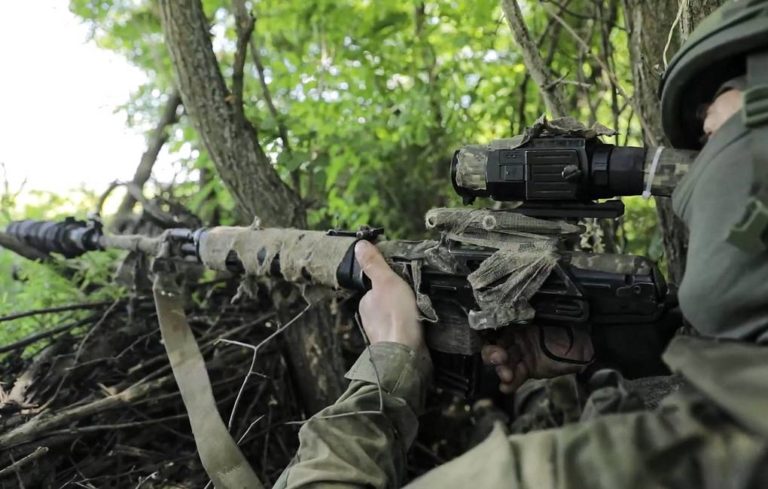
On Monday night, Russian President Vladimir Putin addressed the nation for the second time with the intention to bring the curtain down on the coup attempt by Wagner “founder” Yevgeny Prigozhin on June 23-24. It was quintessentially a self-congratulatory speech — well-deserved, perhaps.
The speech had four principal elements. First, Putin took note right at the outset the “restraint, cohesion and patriotism” that the Russian people had shown, their “civic solidarity and “high consolidation,” and their “firm line… (in) taking an explicit position of supporting constitutional order.”
Putin forcefully contradicted the western narrative that the coup attempt showed cracks in the house that he built since assuming power in 2000. French President Emmanuel Macron rubbed salt in the wound saying that the development revealed a “crack” existing “in the Russian camp, the fragility of both its army and its auxiliary forces, such as the Wagner Group.”
Second, Putin highlighted that the Russian leadership acted swiftly, decisively and effectively — “all necessary decisions to neutralise the emerged threat and protect the constitutional system, the life and security of our citizens were made instantly, from the very beginning of the events.”
Third, Putin went on to roundly condemn the “mutiny plotters” as people full of malignity and evil intentions. But he sidestepped their political agenda as such. After all, a coup is about the usurpation of political power. Presumably, the topic is far too sensitive to be in the public domain.
However, Putin touched the issue tangentially through an enigmatic conjecture as to how if the coup attempt had succeeded, “the enemies of Russia – the neo-Nazis in Kiev, their Western patrons and other national traitors” would have been the beneficiaries, “but they miscalculated.” [Emphasis added.]
Putin didn’t elaborate on any foreign involvement in Prigozhin’s coup attempt. However, the fact that he brought it up at all for a second time, especially of external forces having “miscalculated,” must be noted carefully.
Interestingly, when Foreign Minister Sergey Lavrov was asked about this in an interview with RT, he also parried and replied rather cryptically, “I work in a government ministry that is not engaged in gathering evidence of unlawful acts being committed, but we do have such agencies and, I assure you, they are already looking into it.”
But Lavrov commented on the media reports that Washington contemplated the lifting of existing sanctions against Wagner PMC. “I do not believe that it is a change of approach by the US. It is just another confirmation that the US’ approach depends on what the US needs from a certain foreign actor at this specific stage, be it on the international arena in general, or in some specific country,” Lavrov said. Lavrov recalled that the US intelligence agencies were counting on the success of the coup on June 24.
Fourth, Putin explained the rationale behind his decision to differentiate “the majority of Wagner Group soldiers and commanders (who) are also Russian patriots, loyal to their people and their state.” Putin expressed “gratitude” for the right decision they took “not to engage in fratricidal bloodshed and stopped before reaching the point of no return.” He then offered to them the options of signing a contract with the Defence Ministry or other law enforcement or security agency or to “return home” — or even go to Belarus.
For the Russian public, this was perhaps the most keenly awaited part of Putin’s speech. Putin said: “I will keep my promise. Again, everyone is free to decide on their own, but I believe their choice will be that of Russian soldiers who realise they have made a tragic mistake.”
As in his first speech on Saturday, Putin did not mention Prigozhin by name. But Kremlin Spokesman Dmitry Peskov had disclosed on Monday that a criminal case against Prigozhin would be dropped.
So, what emerges is that Putin approved a general amnesty for those involved in the coup attempt and virtually granted “safe passage” for Prigozhin and his followers to leave for Belarus, as quid pro quo for giving up the coup attempt, while at the same time, making a gracious offer to integrate the Wagner fighters into the Russian state organs or military in the fulness of time. The Russian public will accept this.
Evidently, Putin, who is sensitive to domestic public opinion, carefully weighed that there is a cult of celebrity about Wagner fighters for their courage, heroism, patriotism and loyalty. The saga of liberation of Bakhmut, a long drawn-out war of attrition lasting several months, hollowed out the Ukrainian military and became a defining moment in the war. It is embedded in the Russian psyche.
Equally, a significant section of Russian opinion is in empathy with a thought process aired in public in the recent months — not only from Wagner ranks — that the Kremlin is dragging out the war. Evidently, Kremlin decided that it is prudent not to prosecute Prigozhin for sedition.
A can of worms
The assurance held out by Putin publicly on Monday night would have reassured Prigozhin. At any rate, he flew out of Russia Tuesday morning by his private jet and landed in Minsk at 11.30 am.
Now comes a new twist to the tale. At 3.00 pm Moscow time on Tuesday, Putin gave yet another speech at a meeting in the Kremlin with military personnel apparently to express his “gratitude” to those who were on duty on the fateful days of the coup attempt.
Putin assured the select audience that “everything will be done to support the families of our fallen comrades,” etc. Then, Putin concluded his speech with an abrupt digression into one of Russia’s best kept public secrets — namely, that Wagner company is a progeny of the Russian state.
He said, “those who served and worked for this company, Wagner, were respected in Russia. At the same time, I would like to point out, and I want everyone to be aware of the fact that all of the funding the Wagner Group received came from the state. It got all its funding from us, from the Defence Ministry, from the state budget.
“Between May 2022 and May 2023 alone, the Wagner Group received 86,262 million rubles (approx. $1 billion) from the state to pay military salaries and bonuses… But while the state covered all of the Wagner Group’s funding needs, the company’s owner, Concord, received from the state, or should I say earned, 80 billion rubles ($940 million) through Voentorg as the army’s food and canteen provider. The state covered all its funding needs, while part of the group – I mean Concord – made 80 billion rubles, all at the same time. I do hope that no one stole anything in the process or, at least, did not steal a lot. It goes without saying that we will look into all of this.”
This would be a nasty surprise to Prigozhin in Belarus — Russian authorities are probing him on charges of financial irregularities by his corporate business house!
This will hit Prigozhin where it hurts, for his mother Violetta Prigozhina has been listed as the owner of Concord Catering. Possibly, the vast business empire that the oligarch built, thanks to state patronage — Concord Management and Consulting (construction and real estate development), LLC Megaline ( which hogged most capital construction contracts for the Russian military in 2016) and so on — can also come under scanner.
This will not be the first time that the Kremlin punishes an errant oligarch who strayed into the shark-infested waters of Russian politics. Prigozhin would know that he will have some important choices to make in the coming months — and, possibly, even for the rest of his life.
Of course, Prigozhin’s future moves will be watched keenly not only in Moscow but the Western capitals as well who are far from convinced that the last word has been spoken on the dramatic events.
Against this sordid backdrop, the big question is: Wasn’t Prigozhin’s coup attempt largely a crisis that was waiting to happen, which western/ Ukrainian intelligence exploited? The heart of the matter is, scams follow Russian oligarchs like their shadows, and Prigozhin is no exception. The Russian authorities cannot wash their hands off this shameful reality.
For, after creating the Wagner as a company of private military contractors — similar to Aegis, the British private security and private military company, or Academi, which works heavily with the US military as well as the CIA — the Russian defence and security establishment simply handed over its infant to a powerful oligarch to make a fortune out of it (and possibly share part of the loot with his mentors), whose actual expertise lies in catering business, construction and real estate development!
In comparison, Aegis was led by a former British Army officer, while the founder of Academi (formerly Blackwater), probably the most well-known of all private military companies in America, is a former Navy SEAL officer.
When national security and defence contracts get mired in sleaze and crony capitalism, it is a sign of decadence. If the US is no longer winning its hybrid wars — be it in Afghanistan or Iraq, in the Caribbean or in Africa — the root problem is the hydra-headed corruption spreading its tentacles across the ruling elite all the way to the Pentagon, the Congress and the White House. Now, one can endlessly argue that such malaise is endemic to capitalism, etc., but that is neither here nor there.
Inevitably, Wagner under Prigozhin was going down the same path as the US’ private military contractors — about whom the famous whistleblower Edward Snowden who lives in Moscow has candidly written in his book Permanent Record. Therefore, fortuitously, Prigozhin’s legacy gives the Kremlin a compelling reason to clean the Augean stable. Whether that will happen or not, time will tell.
https://www.indianpunchline.com/prigozh ... -of-worms/
*******

The real casualties of Russia’s ‘civil war’: the Beltway expert class
By Max Blumenthal (Posted Jun 28, 2023)
Originally published: The Grayzone on June 26, 2023 by Wyatt Reed (more by The Grayzone) |
When Wagner Group leader Yevgeny Prigozhin launched a supposed revolt against Russian President Vladimir Putin on June 23, sending his forces on a march toward Moscow following a series of tirades against the country’s defense establishment, Washington’s expert class overflowed with an orgy of regime change fantasies.
For just over 12 hours, everyone from former U.S. ambassador to Russia and noted Hitler apologist Michael McFaul to Ukrainian President Volodymyr Zelensky to neocon pundit Anne Applebaum exploded with seemingly libidinal excitement about a supposed “civil war” that was certain to feature “Russians…killing Russians,” along with “lots of casualties” and Putin “probably hiding somewhere.”
It was as though the Soviet Union was collapsing all over again, and Prigozhin, a character named on the FBI’s most wanted list whom the U.S. government has sanctioned for leading what it described as a “transnational criminal organization,” was suddenly a white knight storming into Moscow to liberate Russia from “the Putin regime” on the back of a tank. Move over, Juan Guaido.
Expecting a bloodbath and seismic political upheaval, corporate networks like CNN had budgeted wall-to-wall coverage of the coup that wasn’t, filling cable news green rooms with rent-a-generals, K Street think tankers, and war-hungry former diplomatic corps hacks.
On the afternoon of June 24, however, news broke across the U.S. that Prigozhin had struck a deal with Belarusian President Alexander Lukashenko to end his protest and go into exile. Thus ended a largely bloodless affair that ultimately saw fewer documented deaths than the January 6 Capitol Riot.
Though the supposed revolt in Russia burned out faster than a Leopard tank on the way to Zaporizhzhia, we now know that a number of serious casualties were incurred inside the DC Beltway. The Grayzone obtained an exclusive look at the massacre some of America’s top Russia experts carried out against their own credibility.
McFaul McFails, again
Ever since he was unceremoniously ejected from Moscow for apparently attempting to organize a color revolution in 2012, Ambassador Michael McFaul has waged a personal jihad against the country’s government. His hatred of the Russian leadership grew so impassioned that he once declared that Putin was morally inferior to Adolf Hitler, embracing a fringe view associated with Holocaust deniers that asserts the Nazi dictator “didn’t kill German-speaking people.”
When the events of June 23 kicked off, McFaul could hardly contain himself. The disgraced diplomat immediately took to Twitter to insist without a shred of evidence to claim that Putin “has ordered his army and others to destroy Wagner & Prigozhin.”
“So there’s going to be a big fight,” he promised.
As for the Russian President, McFaul confidently declared: “I am sure that he is no longer in Moscow.” Just after noon on June 24, he seemed to believe the Russian president’s demise was imminent. “Rats are jumping” from Putin’s ship, he effused, referring to oligarch Arkady Rotenberg taking a flight to Azerbaijan. “This is now a civil war,” the self-styled expert confidently declared.

Anne Applebaum: “Russia is sliding into what can only be described as a civil war”
But around 1:30 PM on June 24, the unwelcome news had made its way to Washington: Putin and Prigozhin had reached an agreement. There was to be no civil war in Russia, after all.
McFaul was suddenly forced to reckon with the reality that his predictions of a coup were premature, and that virtually everything he had said hours before was completely wrong. “Can anyone remember a mutiny or coup attempt that lasted 24 hours and no one really fought or was killed?,” pondered the retired diplomat, seemingly coming to grips with the obvious.
Then, like an alcoholic in denial after yet another blackout, McFaul whimpered,
I was wrong about this. Eager to learn why.
This May, anti-Russian pseudo-scholar and former Iraq war cheerleader Anne Applebaum predicted a decisive Ukrainian counter-offensive that would storm through Russian defenses and not only “liberate” Crimea, but encourage regime change from Moscow to Venezuela.
In an article co-authored by former Israeli prison guard and Atlantic Magazine editor-in-chief Jeffrey Goldberg, and illustrated by the Davos frontman, Bono, (with apparent help from an Etch-a-Sketch), Applebaum openly fantasized about a madman taking control of Russia’s nuclear arsenal. “Even the worst successor imaginable,” she wrote, “even the bloodiest general or most rabid propagandist, will immediately be preferable to Putin, because he will be weaker than Putin. He will quickly become the focus of an intense power struggle.”
By June 24, Applebaum seemed to believe her fever dreams were coming true. And it was then that she breathlessly announced,
Russia is sliding into what can only be described as a civil war.
“If you are surprised, maybe you shouldn’t be,” she lectured readers, just hours before the bloodless “coup” came to a conclusion.
Applebaum’s husband is the former foreign minister of Poland, Radek Sikorski, who infamously tweeted his gratitude to the U.S. government for destroying the Nord Stream pipeline. While Sikorski deleted his tweet, Applebaum’s thoroughly discredited “civil war” article remains on the website of the Atlantic.
On June 25, Applebaum and McFaul were rewarded for their badly botched analysis with an appearance on MSNBC’s “Inside with Jen Psaki,” which is hosted by the Biden White House’s former press secretary.

“The man from the Kremlin is obviously very afraid and probably hiding somewhere, not showing himself,” Ukrainian President Volodymyr Zelensky proclaimed on June 24. According to fact checkers, Zelensky did not issue this bold statement from inside a bunker or in front of a green screen.
The U.S. intelligence “community” claims “surprise”
On Sunday, CNN reported that U.S. intelligence analysts were taken by surprise by “the swiftness of the deal that was struck on Saturday.”
What’s more, they believed that Prigozhin’s march toward Moscow “would encounter much more resistance” than it did.
“I do know that we assessed it was going to be a great deal more violent and bloody,” an unnamed U.S. official reportedly told the outlet.
But DC’s disappointment with the lack of carnage on Moscow streets did not end there.
Kurt Volker declares “the end” for Putin
Kurt Volker is a former U.S. special representative for Ukraine negotiations who also operated as a de facto Raytheon lobbyist while serving as the executive director of the John McCain Institute. Volker also functioned as a liaison for U.S. and Ukrainian business interests while presiding over the founding of American University Kyiv.
During a June 24 CNN appearance, Volker declared that the brief moment of disorder in Russia marked “the end for Putin” and “the beginning of the end of Russia’s war in Ukraine.”
Christo Grozev: Bellingcat’s neocon-stradumus
Christo Grozev is the Russia director of the U.S. and UK government-funded website Bellingcat. This April, Grozev celebrated a terrorist attack that saw a Russian war blogger assassinated and a cafe full of civilians blown up in St. Petersburg, Russia.
With chaos seemingly intensifying inside the Russian Federation again, Grozev suddenly transformed from a glorified OSINT blogger into a geopolitical soothsayer with a unique ability to divine the fate of the Kremlin.
“Prigozhin says he’s got 25k strong army and he’s going to take power and deal with the ‘traitors’ at the top of before returning to the front line,” the Bellingcat commentator claimed on Twitter.
Am old enough to remember how Russia ‘pundits’ said I was talking nonsense predicting a Prigozhin coup attempt this year.
Having not been born literally yesterday, we at The Grayzone are thankfully old enough to remember when Prigozhin’s “coup attempt” failed to materialize and ended quickly with negotiations.
Our memory is so long, in fact, that we recall when the war prophet Grozev stated that Russia had expended 70 percent of its precision missile stocks back in April 2022. Since then, Russian missile strikes on Ukrainian targets have only increased.
Ian Bremmer, the Peter Hotez of international relations
As president of the Eurasia Group risk analysis firm, political scientist Ian Bremmer has leveraged his supposed expertise into a lucrative business.
Bremmer recently weighed in in defense of the absurdly double-talking pediatrician and pundit Peter Hotez, defending his decision not to debate Robert F. Kennedy Jr. on Covid-related issues on the grounds that Hotez was a credentialed expert, and RFK Jr. was not. “It would be like me debating elon [Musk] on electric vehicles. Or him debating me on international relations,” Bremmer argued, asserting his own superior credentials.
There’s no value added.
During the events of June 23, Bremmer joined the rest of the Beltway expert class in predicting imminent doom for Putin. “wagner territorial gains in russia dramatically faster than in ukraine,” Bremmer wrote in a viral post seen by more than 1 million Twitter users. Moments later, he joked that “ukraine has run out of popcorn,” implying that Kiev was eagerly preparing for Russia’s collapse.
Following the announcement of Wagner’s stand-down on June 24, an apparently disappointed Bremmer insisted “there’s no environment where [Putin and Prigozhin] hug it out.”
Top Biden officials’ travel plans interrupted
Among the most overlooked victims of the brief march on Moscow were high-ranking U.S. officials’ weekend plans.
On Saturday, a spokesman for the Joint Chiefs of Staff announced that a planned visit to Jordan and Israel by Gen. Mark Milley, the top military officer in the U.S., had been canceled “due to the situation in Russia.”
Biden administration National Security Council director and possible human scarecrow Jake Sullivan was forced to cancel a trip as well. Sullivan had reportedly been slated to attend a conference on Ukraine in Denmark until Prigozhin decided to make a trip of his own toward Rostov-on-Don.
Stephen King, lost in fantasy
Horror author-turned-liberal Russiagate conspiracist Stephen King, who once praised Ukrainian Nazi collaborator and Holocaust perpetrator Stepan Bandera in a phone call with a prankster he believed to be Volodymyr Zelensky, was clearly titillated by the events of June 23. When Prigozhin’s forces briefly took over the city of Rostov-on-Don, King once again proved unable to contain his overactive imagination. “Putin sowed the wind. Now he must reap the whirlwind. Slava Ukraini!” he exclaimed.
Noted online stalker Idrees Ahmad predicts “the death of Aaron Mate’s career”
Idress Ahmad once existed on the margins of the UK’s antiwar movement, publishing a book attacking the Iraq war-era neocon cabal, suggesting Senators Barbara Boxer and Russ Feingold voted for Iran sanctions because they are Jewish, and openly questioning the West’s narrative of a genocide in Darfur.
After running into financial trouble and escaping deportation to his native Pakistan “against the odds” thanks to a Home Office decision that remains unexplained, Ahmad transformed into the very thing he once condemned.
Having re-emerged as a rabid supporter of the West’s dirty war on Syria, Ahmad busied himself by stalking The Grayzone, even phoning its editor, Max Blumenthal, to threaten him against publishing a factual investigation of the Syrian White Helmets in 2016.
While Ahmad’s recent work at the spook-infested Newlines think tank has failed to generate much interest, even among his fellow regime change cheerleaders, we noticed his June 24 prophecy that Prigozhin’s “coup” would lead to the collapse of The Grayzone, the international committee of the Democratic Socialists of America, and “the death of Aaron Mate’s career.”
At the time of publication, we are still triggering Ahmad’s rage-a-holic personality while his own media career has gone about as far as Prigozhin’s march toward Moscow.
https://mronline.org/2023/06/28/the-rea ... civil-war/
*******
Further thoughts on the lessons of the Prigozhin armed rebellion
Russia is clearly the flavor of the day as regards punditry: in mainstream, in alternative news and in social media. The Prigozhin affair this past weekend has provided a wealth of material for speculation, which is the stock in trade of talking heads. The preponderant share of what we see and hear is contributed by Russia’s detractors and enemies, though Russia’s cheerleaders also have found their voice. I do my best to stay outside these stereotypical camps and to offer an independent point of view.
I open today’s essay with a brief observation on what others have been saying. I will not clutter my text with links, since every able-bodied reader can easily find the original pieces in Google Search by entering author and title or publisher.
Then I will move on to the fresh material that I gathered from last night’s edition of the Vladimir Solovyov talk show. Here my providing the link is essential for anyone wanting to go to the source:
https://smotrim.ru/video/2639845?utm_so ... ain2-theme
With respect to my use of Solovyov, the other day I received a query via the Comments function of this site asking why I do not present material from other Russian talk shows, and, in particular, from “The Meeting Place” (Место встречи) of the commercial television station NTV. There are a couple of reasons for this. The least contentious is that only programs on Russian state television can be viewed anywhere in the world thanks to the smotrim.ru website. NTV is widely distributed within Russia, but is inaccessible here in Belgium, where I am working most of the time. I imagine it is inaccessible in the world generally. However, the decisive argument for me is that whatever you think of the host and his occasionally rude and overbearing behavior towards panelists, his guests are among the most authoritative political, social and artistic personalities in the country, making his program incontournable, as the French say.
That this is so was demonstrated persuasively in two successive articles just published by Max Seddon in The Financial Times. His “Traitors must be shot” and “Russia and its propagandists” both drew heavily on what was said in the Sunday night broadcast of the Solovyov show. Given that the first of these articles appeared well after my essay “Dry Residue,” I may be flattered that Seddon picked up my idea of featuring two key panelists, Lt General Andrei Gurulyov and RT editor in chief Margarita Simonyan, to characterize the divided opinions in Russia over the mutiny and the terms of its settlement. This use of material from his program occurred even though the Financial Times routinely denounces Solovyov as a pro-war propagandist for the Putin regime.
I mention in passing that I have written a letter to the Editor at FT demanding an apology from Seddon over his Plagiarism Lite of the substance of my published and copyrighted essay and also pointing to the violation of intellectual property rights of Evening with Vladimir Solovyov in a way they would never dare to do had the broadcaster been CNN or Euronews: Gurulyov and Simonyan were quoted without mention of the show as the source. Quite apart from the scurrilous descriptions Seddon assigns to identify these speakers, what we have here is blatant journalistic malpractice.
*****
A magisterial critique of mutiny articles and television appearances by well known Russia-haters was published a couple of days ago on thegrayzone.com by Max Blumenthal: “The real casualties of Russia’s civil war’: the Beltway expert class.” Here Blumenthal presents the rabid nonsense that was published as articles or tweets, or spoken on television over the weekend by Anne Applebaum, Michael McFaul, Kurt Volker, and Christo Grozev (Bellingcat), among others.
I am obliged to add a word about Applebaum that would not necessarily be obvious to readers of Blumenthal’s critique of her essay and television appearances. Namely, her diligence in pursuit of her propagandistic Neocon objectives should not be underestimated, nor should her intellectual gifts. I recall with some regret the public televised debate about Putin’s Russia that Applebaum had with Steve Cohen at a Canadian university. This took place about three years ago, when I was in regular correspondence with Cohen and took the time to watch his debate. It was a debacle. Applebaum came very well prepared to argue her case. Cohen quite obviously had done nothing to prepare, had not trained with sparring partners. He relied instead on spontaneity, on his superior intellect and broad knowledge. In the ensuing exchange on stage, Applebaum wiped the floor with Cohen, whose thinking and argumentation were outdated. The moral of the story is: never to be dismissive of an enemy.
Blumenthal does not speak about Anatol Lieven, and so I add my two cents here.
Lieven enjoys high ratings in Liberal circles for being a supposedly fair-minded and erudite commentator, as well as having a lot of life experience in war zones. Among his present calling cards is as a top officer in the Quincy Institute for Responsible Statecraft. He is the principal adviser on Russian matters to the think tank’s president Andrew Bacevich, who is clueless.
My repeated finding on Lieven is that he is the consummate chameleon, playing to both sides on the Russian issue, while raking in the chips in terms of honorary and paid positions, speaking engagements and the like.
Less than a week ago, even I was taken in by an article authored by Lieven denouncing the “cancel Russia” movement. However, over this past weekend Lieven shed all pretence at respectability. This sad fact emerges from his latest article dealing with the Prigozhin adventure: “Putin: Disastrous but indispensable for the system he created?” in the online journal Responsible Statecraft?” In short, Anatol Lieven is just one more purveyor of State Department snake oil.
*****
The edition of the Solovyov talk show last night was notable for a video excerpts he put on screen from President Putin’s address to military commanders earlier in the day and also for a resume of President Lukashenko’s televised address to his nation provided by a political analyst in Minsk. And then there were the remarks of two panelists on the present situation post-mutiny that I will summarize below, because they point to the seriousness of political commentary on Russian state television.
As for Putin, he was addressing precisely the military commanders who had personally implemented measures to stop Prigozhin’s march on Moscow. Said Putin, “had you not stopped the mutiny on its path, there would have been chaos in the country that our enemy would take advantage of, as he is doing even now, with the result of our possibly losing all that we have achieved so far in the SMO.”
A panelist on this morning’s Sixty Minutes news and discussion program explained that these were the officers who assembled troops, tanks and other heavy equipment that they put in the way of the force advancing on Moscow. Prigozhin and his confederates saw this and understood that they faced a bloody fight. That led them to enter into talks with Lukashenko on a peaceful settlement.
Here below I offer the gist of what Putin told these men:
We always had great respect for the Wagner forces. They showed courage on the battlefield. Our soldiers and officers in the regular army also showed heroism and self-sacrifice on the field of battle. But they have worked with less effect. And so those who were in the Wagner Group had the respect of our country.
The upkeep of the Wagner Group was fully paid by the state, by the Ministry of Defense, from the state budget. Just from May 2022 to May 2023, the state paid to Wagner for upkeep and motivation rewards 86 billion 262 million rubles (circa 1 billion euros), of which 70 billion was cash for upkeep and 15 billion was motivation rewards. In addition the owner of the company Konkord [part of the Wagner Group] via Vointorg received 80 billion rubles to provide food provisions to the Army. I hope that in the course of this work no one stole anything or, shall we say, didn’t steal much. We will definitely look into this.
Solovyov reminded the audience that the column of Wagner troops was advancing very quickly through civilian territory and was heavily armed. However, the Rosgvardia forces did not tremble. They stood their ground. The head of the Emergencies Ministry phoned them and said he had 400 men to contribute to the stand against Wagner.
We were now shown a video of the head of Rosgvardia Army General Zolotov speaking to reporters
We had to consolidate otherwise they would pass like a knife through butter. They could have reached the outskirts of Moscow but they could not take Moscow.
Solovyov’s conclusion: Rosgvardia does not yet have its own heavy military equipment or aircraft or air defense systems. But that will now all change.
Solovyov then turned the microphone over the Duma member and Lt. General in retirement Andrei Gurulyov, the very same Gurulyov whom I cited in my article Dry Residue and whom Max Seddon also quoted in his FT article. This time his temper cooled, and Gurulyov was no longer calling for Prigozhin to be meted out the traditional bullet to the head.
Andrei Gurulyov:
We are just at the start of the long road to understanding what happened. But I want to say the following:
When people say we should prohibit Private Military Companies, I remind them that in the real world today there is hybrid war. Part of hybrid war is such Private Military Companies. They should operate not only in Ukraine but on any spot of the globe in the interests of the state. This should be regulated but units like the Wagner Group are very much needed.
I agree with what you said about those who came to stop the advancing Wagner forces. Among those whom Putin met with today was the head of the Frunze military academy, who has fought in all our wars, and he sent people from his officer school to help stop Prigozhin. The police also joined in. They all were there to ensure that no one would approach the Kremlin and that we would not have a coup d’etat.
I want to point out that the Wagner Group was also very active on the Information front. Everyone knows they have their own troll factory. They have worked to influence public opinion. We have to give this our attention right now while their military units are being disbanded.
Thirdly, note that the Wagner Group had many former officers, who are well trained. It is very desirable that they now sign up with the ministry of Defense. We need them in areas under direct Ukrainian attack.
As for defense of Moscow, we have a unit there with heavy equipment, well prepared to block any assault on the city. Such a force always must be in place and ready, regardless of any war. Soviet history taught us that.
Another point – we have shortage of lower officer ranks. Yes, sergeants should be moved up into officers, but for that they must get additional professional training. 3 month courses.
Lastly, per Lukashenko in speech today we have to ensure that 100% of the population is behind the war effort. There are always some who are quiet resisters. As Lukashenko said, in moments like the mutiny the cockroaches who have been hiding in the woodwork are flushed out.
Last night the role of counterpoint to Gurulyov, the hardliner, that on Sunday night had been played by Margarita Simonyan, was assumed by the head of Mosfilm and popular film director Karen Shakhnazarov, whom I have quoted on these pages several times.
Karen Shakhnazarov
A mutiny is by its nature is always disorderly. If it is well planned and then succeeds, it goes by a different name. I personally was involved in a mutiny, so to speak. I got arrested in the street during the August 1991 coup against Gorbachev. It was disorganized, but it had consequences. It led to the breakup of the USSR.
This mutiny worked against our national interests. It persuaded our enemies that we are weak. See the reaction of Chancellor Scholz. It raised doubts about us among our friends. So whatever we say about this demarche now, it caused great damage. The president is now trying to compensate and strengthen things.
Four weeks, maybe six weeks ago I spoke out on this program when this fellow whom I will not name was in full public dispute with the Minister of Defense. I said the Government had to do something about this. The whole country saw it. But I did not see any reaction. I am uncertain that my words reached the President. I think his subordinates did not report this properly to Vladimir Vladimirovich.
This episode did harm to our stability. It also removed from the front a very much needed contingent of troops.
I understand that the President met today precisely with soldiers. That was correct. The President has a feel for these things. After all, if 10,000 troops went along with the mutiny, then maybe other soldiers and officers could be won over. Putin demonstrated today his relations with the Army.
What I don’t agree with in the President’s actions is his comparison of this mutiny with events of 1917. This was not like February 1917. At that time Russian society, Russian elites completely lost their trust in the top authorities. That’s how it was. This time the situation was entirely different. Trust of society to the President was enormous. It has even grown. There is trust in the Army. The war is going on and who likes it? But its objectives are known to the people, unlike the situation back in 1917. This affair with Wagner shows that the people are behind the President. . Even those who are not especially loyal understand the objectives. Our people fully understand that we must not allow a mutiny to cause chaos. We have that in our genes, unlike the people of the Russian Empire in 1917. Thank God!
I have read what they are saying in the West. Liz Truss is commenting again. But you have to be a complete idiot not to understand a very simple thing: what it would mean if such chaos, if a civil war broke out in a country like Russia with its nuclear arms. And it is not those whom they want who would come to power, quite the contrary. Only the most radical, nuclear-minded people would take over. They wouldn’t hesitate for a moment. They would send the Poseidon to where it should go. And the Sarmat…[Russia’s heaviest and most advanced strategic nuclear missile]. Maybe this mutiny will clear minds somewhere about the danger. You have to be a complete idiot not to see this could be a catastrophe for the whole world. And so, even those here who may not be particularly loyal have to understand that the President is uniting us.
©Gilbert Doctorow, 2023
https://gilbertdoctorow.com/2023/06/28/ ... rebellion/
******
Chronicle of the special military operation for June 28, 2023
June 29, 2023
Rybar
Fighting continues across the front line. In the Kharkov region, the enemy is concentrating forces near the border opposite the Belgorod region . In Serebryansky forestry, the advance of the RF Armed Forces is recorded, and near Bakhmut, Ukrainian formations have stepped up attacks on Russian positions.
At the same time, the most fierce battles continue in the Yuzhnodonetsk and Zaporozhye directions: on the Vremievsky ledge, the enemy is entrenched in recaptured territories, near Orekhov and Pyatikhatki, units of the RF Armed Forces repelled all attacks.
Details of an attack on a cluster of mercenaries in Kramatorsk continue to surface . The target was high-ranking military leaders of the Armed Forces of Ukraine, there were many foreigners at the site of the strike, including those with chevrons of US elite units.
Armed Forces of Ukraine continue the artillery terror of Donbass. Massive strikes continued in Donetsk and neighboring settlements, three civilians were killed, 11 more were injured, of which five were children.

Consequences of a missile attack on Kramatorsk
On the evening of June 27, Russian troops attacked the RIA Lounge restaurant in the center of Kramatorsk with an Iskander ballistic missile.
In the arrival area were mercenaries, among whom managed to identify Alex Gallant ( Alex Gallant ), Arno Dedeker (Arnaud Dedecker) and Nick Dukvorta ( Nich Durkworth ), as well as three Colombian citizens. In one of the video from the field, you can also see that one of the wounded has a tattoo of the 3rd Battalion, 75th Ranger Regiment of the US Armed Forces on his arm .
However, foreigners were not the main target of the strike at all: there were several specific representatives of the command staff of the Armed Forces of Ukraine in the ranks up to the general at the facility. As Elder Edda rightly noted , this is indicated by at least a parked army SUV without a driver that got into the frame.
The statement of the SBU about the capture of an employee of a gas transportation company who made covert filming of those inside the restaurant also speaks in favor of the version. Such extremely quick work to find spotters usually occurs in the event of a hit on important locations.
Unfortunately, the strike on the object in Kramatorsk was not without casualties among civilians. In total, local authorities reported the death of 10 people, but it is unlikely that they included those who were the real target of the strike: as often happens, their names will “pop up” in the Ukrainian media after some time.
The situation on the front line and the fighting
In the Kharkiv region, the Ukrainian command continues to concentrate forces on the border with the Belgorod region, preparing for a possible offensive through Valuiki. Russian subunits are reinforcing the defenses and delivering strikes against exposed enemy concentrations.
In the Starobelsky direction, the servicemen of the RF Armed Forces continue to methodically advance in the area of the Serebryansky forestry . In turn, the Armed Forces of Ukraine are deploying additional forces to the site, intending to hold back the onslaught of the attackers.
A tense situation remains in the Bakhmut direction , heavy battles are going on. To the south, the Armed Forces of Ukraine are increasing pressure on positions controlled by the Russian Armed Forces. The enemy is pressing through the water canal on Kurdyumovka and Ozaryanovka , the situation is complicated.
There were also no significant changes in the front line in the Donetsk direction . There are heavy positional battles in the area of \u200b\u200bthe Avdeevsky ledge and Marinka , as well as the surrounding area.

In the area of the Vremyevsky ledge , three company groups of the 35th infantry regiment and the 128th infantry fighting regiment on several armored combat vehicles and infantry fighting vehicles entrenched themselves in the area west of Staromayorsky . A little to the north, members of the 31st brigade of the Armed Forces of Ukraine from Rivnopol took up positions .
Judging by enemy movements, Russian fighters withdrew from positions between Staromayorsky and Rovnopol . At the moment, the Armed Forces of Ukraine are equipping strongholds, mining approaches, and have also deployed ATGM crews. In addition, a unit of the 37th Marine Corps arrived in the area.
Now the DRG of the 88th battalion of the 35th infantry regiment has advanced in the direction of Priyutnoye , trying to strike at the flank of the defense of the Russian army. At the same time, a simultaneous attack from Levadny and Rovnopol is not ruled out.
 Orekhovsky section of the Zaporozhye direction, Ukrainian formations continue rare attacks on the positions of Russian troops.
Orekhovsky section of the Zaporozhye direction, Ukrainian formations continue rare attacks on the positions of Russian troops.Pyatikhatki are still in the gray zone. At night, the Armed Forces of Ukraine made an attempt to sortie to Zherebyanki . According to South Wind @south0wind, the enemy led the offensive with forces up to a company, after the loss of two infantry fighting vehicles due to Russian ATGMs, the Armed Forces of Ukraine retreated again.
The enemy's DRG, numbering up to 15 people, went on guard in the settlement. Lugovskoe . Right now, a shooting battle is going on, Russian artillerymen are working with cannon artillery and mortars.
A Far East warrior reports a thwarted enemy sortie near Rabotino : most likely, the assault groups of the Armed Forces of Ukraine tried to gain a foothold at a height of 137.8 north of the settlement, but after artillery strikes they were dispersed.

In the Kherson direction , the Armed Forces of Ukraine continue to hold a bridgehead on the islands in the Dnieper delta near the Antonovsky bridge . Russian troops delivered a massive blow from heavy flamethrower systems to enemy positions, but part of the enemy forces still remained under the bridge. And later, additional Ukrainian reinforcements were transferred to the site.
Enemy attempts to gain a foothold were noted in the area of several islands south of Kherson . There is no confident control of the Russian side over the gray zone in the region of the islands. At the same time, at the turn of the Iron Port - AzureA sabotage group of the Armed Forces of Ukraine tried to land on a small boat. According to unconfirmed reports, as a result of the ensuing battle, the Ukrainian unit was forced out of the area.
Shelling of rear territories and residential areas
Despite the persistence of a tense situation in the border areas of Russia, over the past day the enemy has reduced the intensity of shelling of settlements in the Bryansk , Kursk and Belgorod regions. Nevertheless, the sides continued to conduct mutual reconnaissance and counter-battery combat along the entire border.
The Armed Forces of Ukraine again dealt a massive blow to the Donetsk agglomeration . During the day, more than thirty artillery strikes were inflicted on settlements , as a result of which at least 157 shells were fired from MLRS and cannon artillery of 122 and 152 mm caliber.

Under enemy fire Petrovsky , Kirovsky , Kuibyshevsky and Kievsky districts of Donetsk , Yasinovataya , Makeevka and Gorlovka .
Three civilians were killed and 11 injured, houses and infrastructure facilities were destroyed and damaged. Of the injured, five were children.
The Zaporozhye region of Russia was also shelled. Air defense was working in Melitopol at about one in the morning and eleven in the morning, and a locomotive depot was fired at in Pologi , resulting in a fire.
In the neighboring village of Inzhenernoye, a residential building was destroyed as a result of shelling by Ukrainian formations. Luckily, there were no casualties.
In the Kherson region, Ukrainian formations continue to fire dozens of shells at settlements on the left bank of the Dnieper: Novaya Kakhovka , Aleshki and Vasylivka were hit, among others . According to preliminary information, there were no casualties.
Political events
On the possible membership of Ukraine in NATO
Estonian Prime Minister Kaja Kallas said that a “surprise” awaits Ukraine at the July summit regarding membership in the North Atlantic Alliance.
About military supplies
Lithuania decided to buy Ukraine two NASAMS anti-aircraft missile systems. The purchase price is $10.7 million. It is planned that the Armed Forces of Ukraine will receive them within three months. In addition, Lithuanian Defense Minister Arvydas Anusauskas said that the Lithuanian authorities ordered 12.5 million ammunition for Ukraine, of which 2.5 million will be transferred in the near future.
Ukraine is negotiating with Poland on the purchase of a battery or a division of NSM coastal missile systems. If successful, the complexes will be purchased at the expense of Kyiv or the European Military Assistance Fund.
In turn, the Swiss authorities rejected the application of one of their companies for the sale of 96 Leopard 1 tanks to Ukraine.
On the trial of the Azov National Regiment in Rostov-on-Don
In Rostov-on-Don, a trial was held in the case of 22 militants of the Ukrainian nationalist regiment " Azov ", who surrendered last spring in Mariupol . Each of the defendants in the case is accused of participating in a terrorist organization and forcibly seizing power. Throughout the meeting, the defendants behaved imposingly, deliberately smiling.
Since the criminal case was started under the Criminal Code of the DPR, this led to bureaucratic delays. As a result, the court decided on the need to bring the process in accordance with all-Russian laws. The next meeting is scheduled for July 19.
https://rybar.ru/hronika-speczialnoj-vo ... 2023-goda/
Google Translator
(Other images at link.)
******
From Slavyangrad's Telegram account:
Slavyangrad
According to a statement from the Russian Defence Ministry, a pizzeria in Kramatorsk near the Kramatorsk hotel on a strike on 27 June were destroyed:
2 AFU generals
Up to 50 officers of the AFU
Up to 20 foreign mercenaries and advisers.
Good catch.
***
Slavyangrad
Kiev continues to convince population of inevitability of catastrophe at ZNPP: exercises in case of an explosion at the nuclear power plant start today in Zaporozhye
The formal objective is to coordinate the actions of all services in case of a threat of an act of terrorism at the Zaporozhye nuclear power plant.
The region autorities added that the situation is under control.
Apparently, Kiev has started nuclear blackmailing of Western countries. The possibility of the Ukrainian special services bombing the Zaporozhye nuclear power plant has been discussed since last summer.
https://t.me/s/Slavyangrad



